Click here for an article in English
(2021年9月10日加筆修正)
早いもので「あの時」からもう20年が経とうとしています。「あの時」私は、一番目のタワー(タワー2)が崩壊したところに遭遇しました。今回のブログでは、記憶が薄れ記録が失われてしまう前に、WTC崩壊現場に遭遇し学んだことについて書きたいと思います。当時の具体的な写真がいくつか入っているので、苦手な人はお気をつけください。なお、今回ブログで使用した写真は全て、当時私が現地で撮影したものです。
ニューヨークでの設計事務所勤務
当時私はボストンの大学院を卒業後、ニューヨークの建築設計事務所Pei Cobb Freed and Partnersに勤務し始めて1年少々が経とうとしていたところでした。同僚や上司にも恵まれ、仕事を覚え始めた楽しい日々でした。プロポーザルや締切がない普通の日には、毎日ほぼ7時ごろには仕事を切り上げます。友人と飲みに行ったり、ギャラリーのオープニングに行ったり、映画や音楽を聴きに行ったりと、仕事後も大変充実していました。
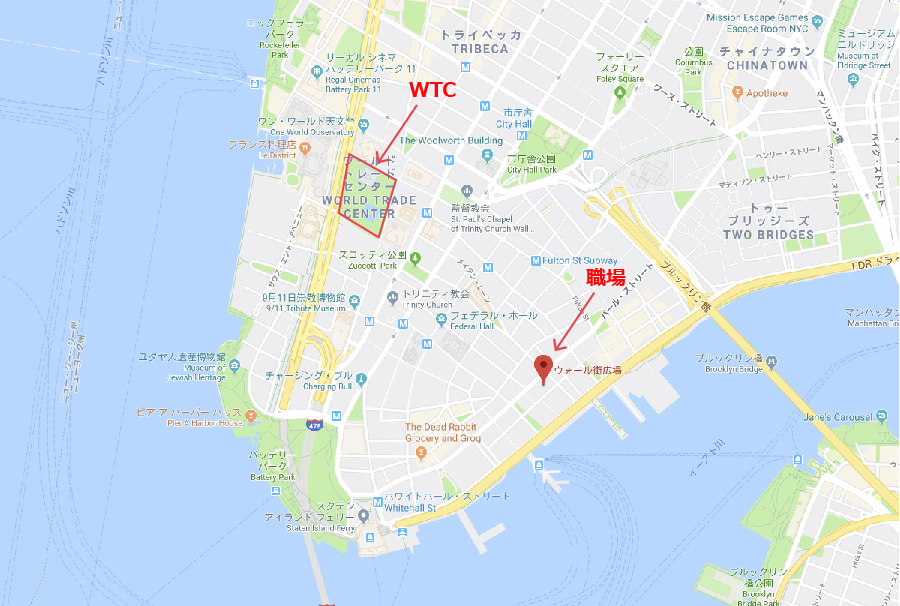
職場は、ダウンタウンの88 Pine St.にあり、WTCまでは歩いて10分弱のところです。
同僚たちと、頻繁にランチにも出かけました。毎年、レストランウィークというイベント時期には、高級店でも格安ランチが食べられます。この写真(2001年2月1日撮影)は、同世代の同僚たちと、WTC最上階にあったレストランWindows on the Worldでランチをした時の写真です。中国系アメリカ人建築家の中で最も有名なI M Pei氏の名前に魅せられて、多くの中国系の若者が勤務していました。写真に写っているのは右から、台湾人、私(日本人)、シンガポール人、中国人、香港人、中国系アメリカ人という組み合わせです。公用語は英語と中国語(北京語)という環境でした。
 WTCのNorth Tower (Tower One)最上階(106階と107階)の立地を誇るレストランですから、WTCやウォールストリート界隈に勤務しているビジネスマンや観光客で常ににぎわっていました。
WTCのNorth Tower (Tower One)最上階(106階と107階)の立地を誇るレストランですから、WTCやウォールストリート界隈に勤務しているビジネスマンや観光客で常ににぎわっていました。
 またその名前だけあって、景色が良いレストランでした。写真下から、Brooklyn Bridge(ブルックリン・ブリッジ)、Manhattan Bridge(マンハッタン・ブリッジ)、さらに奥にはWilliamsburg Bridge(ウィリアムズバーグ・ブリッジ)が見えます。
またその名前だけあって、景色が良いレストランでした。写真下から、Brooklyn Bridge(ブルックリン・ブリッジ)、Manhattan Bridge(マンハッタン・ブリッジ)、さらに奥にはWilliamsburg Bridge(ウィリアムズバーグ・ブリッジ)が見えます。
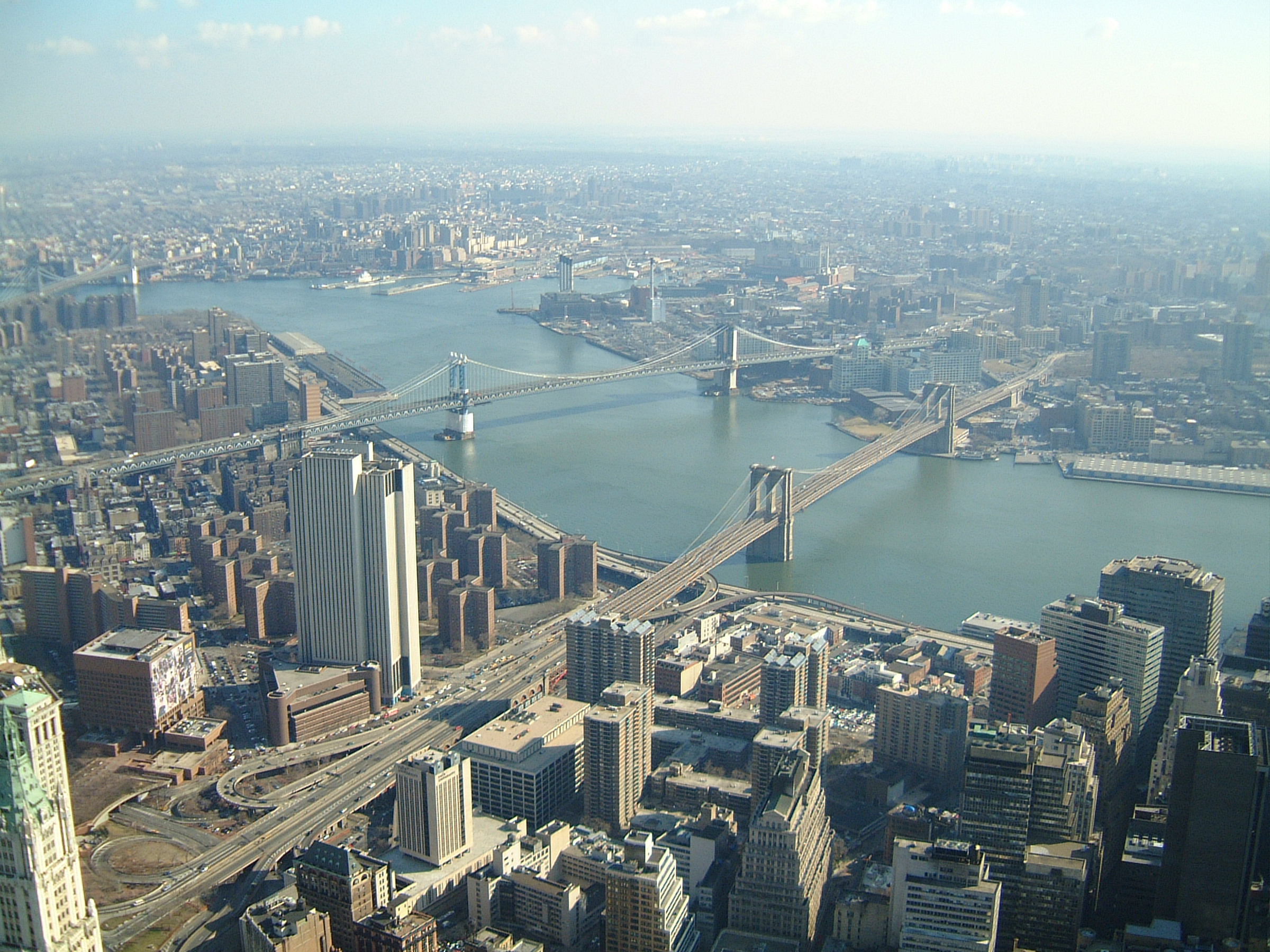
さすがに100階以上からの眺めは格別で、低い雲に覆われた天気の悪い日は、地上の天気とは一転して、太陽が見える時もあったと聞いたことがあります。本当かどうか今となっては知る由もありませんが。
こうして皆で仲良くランチを楽しんでいる時は、まさかWTCがテロの標的になるとは全く考えもしませんでした。
朝起きると
9月11日の朝、いつも通り起床して会社に向かう仕度をしていました。当時私は、Brooklyn(ブルックリン)のClinton Hill(クリントンヒル)という場所に住んでいました。Pratt Institute(プラット・インスティチュート)という美術系大学の最寄り駅です。Gラインというマイナー地下鉄線のClinton-Washington Avenues駅から1ブロックほどしか離れていないアパートで、会社までおよそ40分で到着します。
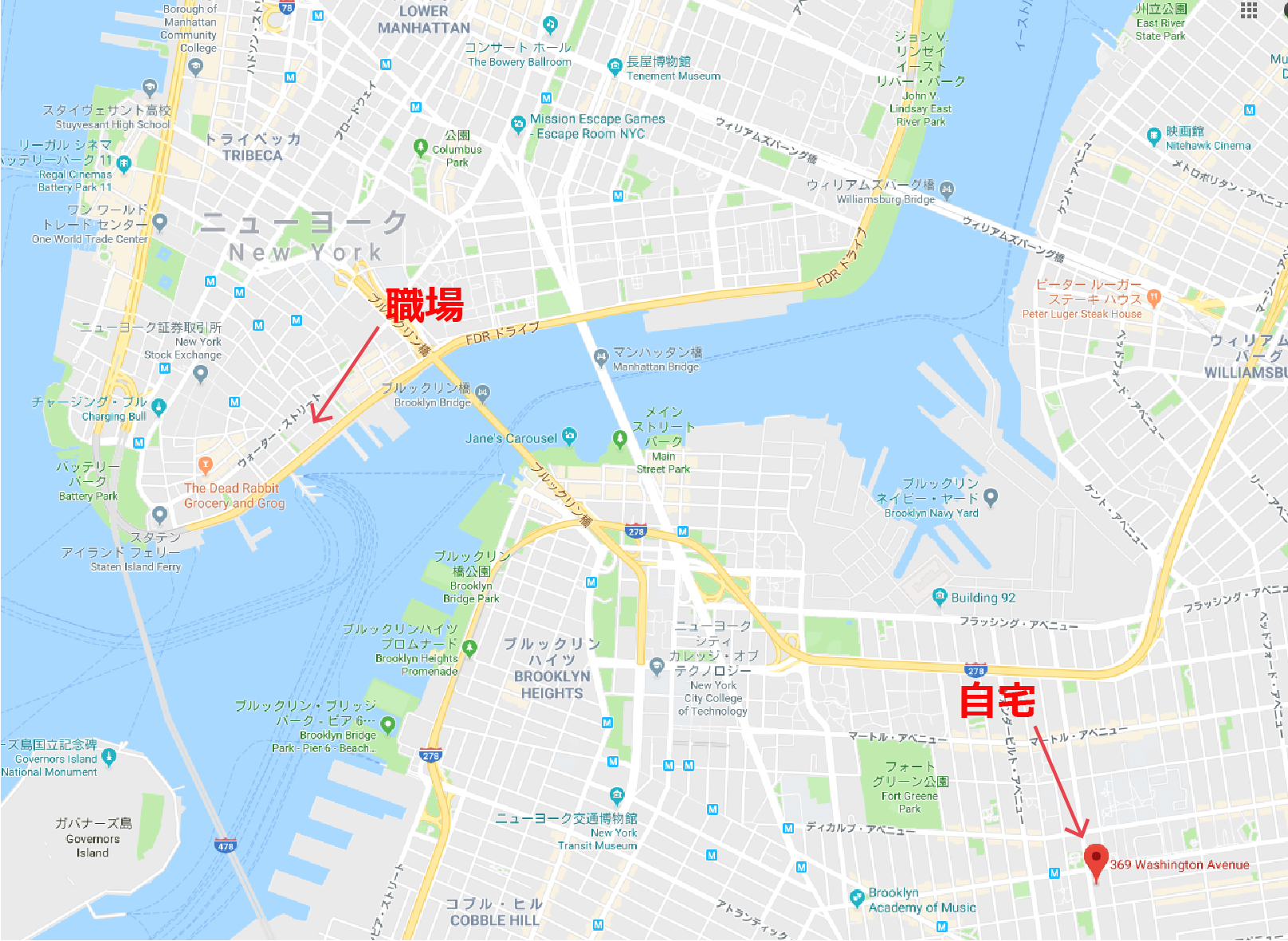 一人暮らしだった私は、朝起きるとまずNY1 というNewYorkローカルのTVニュース番組を見るのが日課でした。その朝は「WTCで火事が起こったらしい」という内容の放送をしていたのですが、私はその重要性・緊急性については特に気が付きませんでした。「たぶんボヤ騒ぎですぐに消火されるだろう」と大して気にも留めず、眠い目をこすってシャワーを浴びに行きました。
一人暮らしだった私は、朝起きるとまずNY1 というNewYorkローカルのTVニュース番組を見るのが日課でした。その朝は「WTCで火事が起こったらしい」という内容の放送をしていたのですが、私はその重要性・緊急性については特に気が付きませんでした。「たぶんボヤ騒ぎですぐに消火されるだろう」と大して気にも留めず、眠い目をこすってシャワーを浴びに行きました。
シャワーから上がると、テレビが映らなくなっていました。「テレビ壊れたのかなぁ」と不思議に思ったのですが、特に気にも留めずに身支度をして、会社に向かうことにしました。後から知ったのですが、WTCの頂部にTV配信用アンテナが立っており、そのすでに火事の影響でTVが映らなくなっていたようです。
Broadway-Nassau駅に着くと
職場最寄りのBroadway-Nassau駅(今のFulton St.駅)は、WTCの最寄り駅の一つでもあります。駅に到着し出入口の階段を上がると、何やらあわただしく騒いでいる人がたくさんいます。テレビで放送していたボヤ騒ぎでしょうか?みな何かを眺めています。
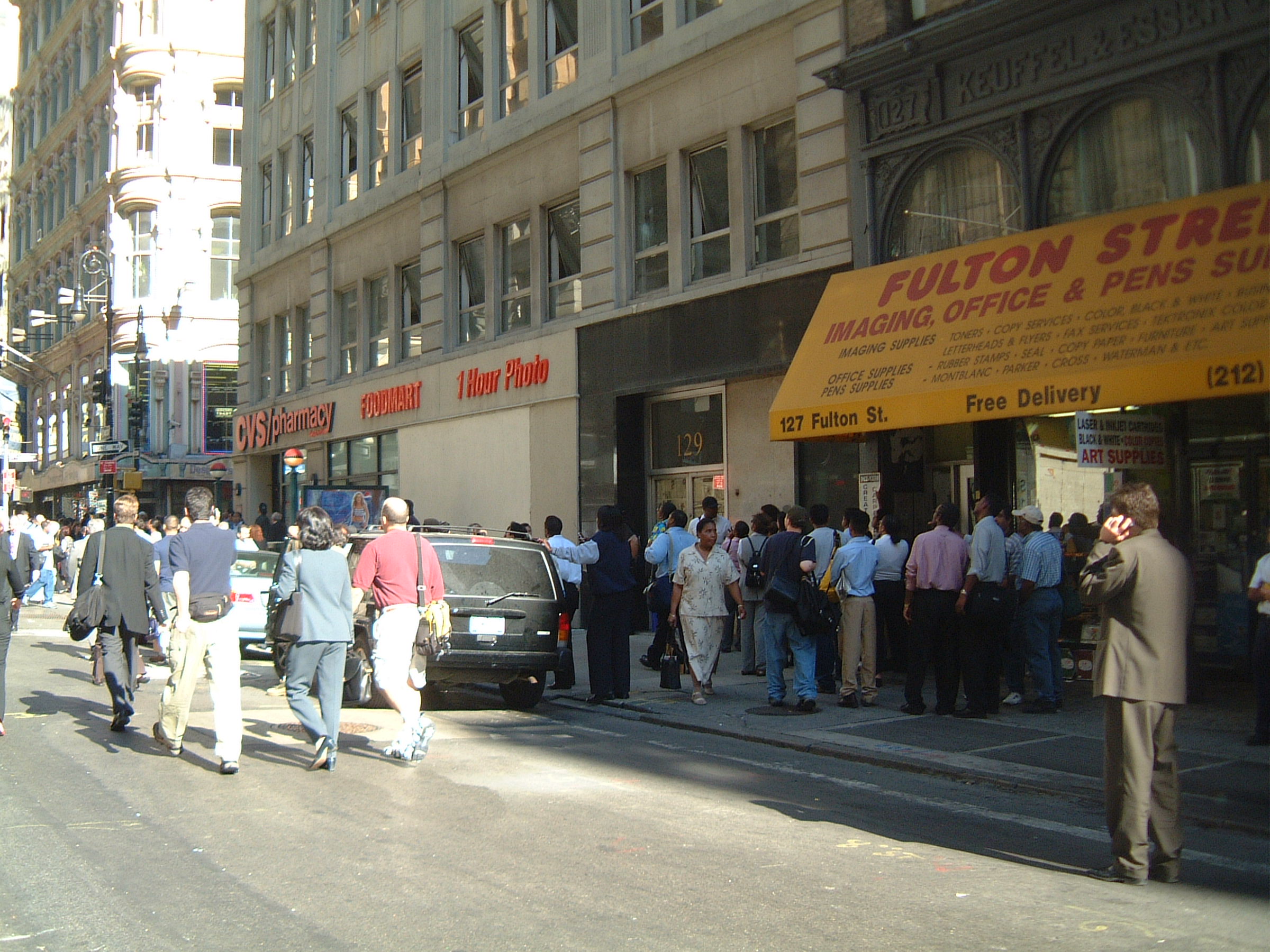
WTCに目を向けると、激しく燃えています。今にも増して好奇心旺盛だった私は、いてもたってもいられず、WTC方面に歩き出しました。その時は、これからWTCが崩れてくることになるとは知る由もありませんでした。
 引き寄せられるようにBroadwayまで歩いてみると、野次馬や警察官やニュース取材でごった返しています。
引き寄せられるようにBroadwayまで歩いてみると、野次馬や警察官やニュース取材でごった返しています。
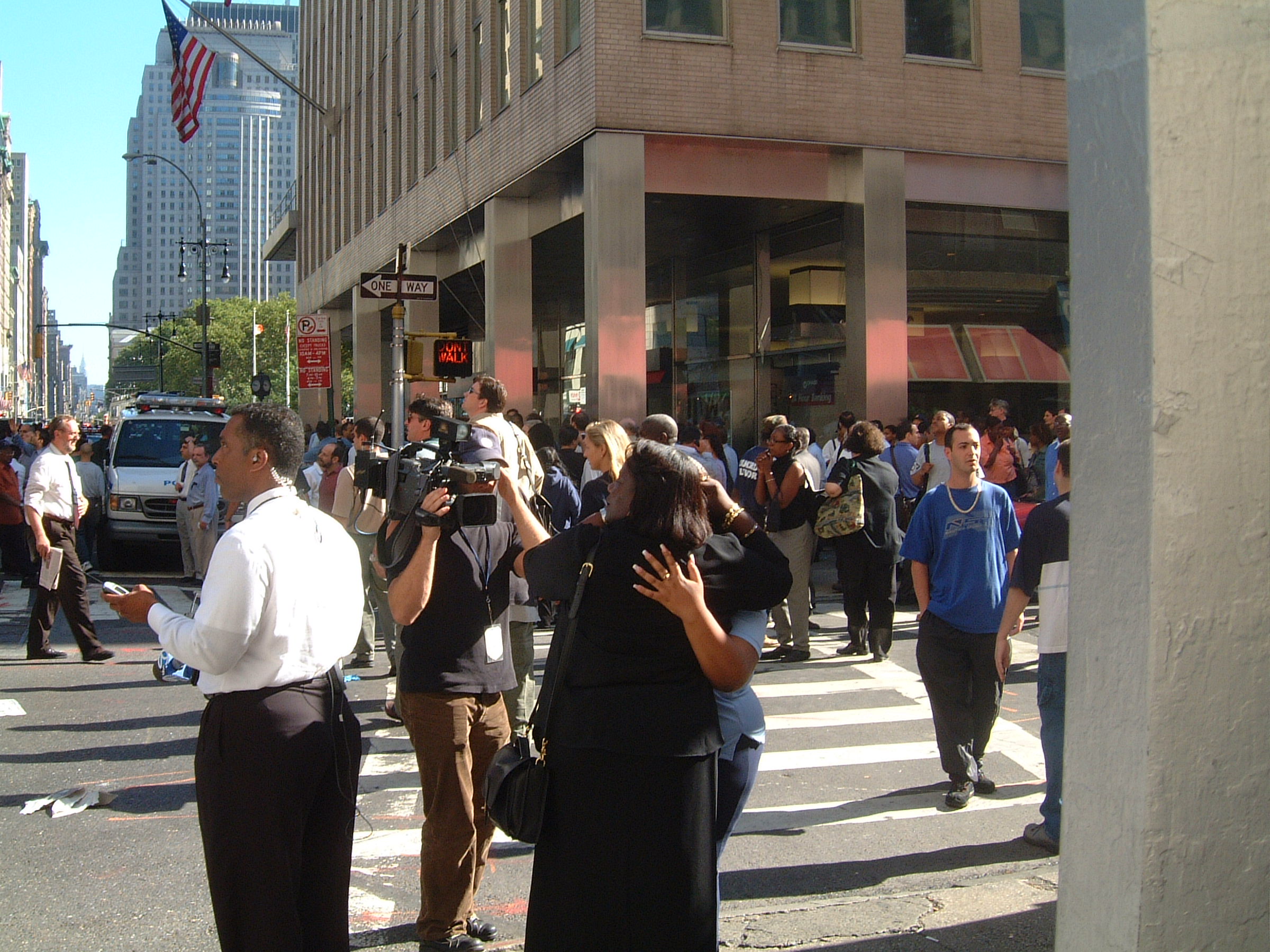 Broadwayを境界として立ち入り禁止の黄色いテープが張られており、これ以上、WTC側に近づくことができませんでした。(この黄色いテープがなく、もっと近づいていたら、今頃こうしてブログを書いていなかったかもしれません。)
Broadwayを境界として立ち入り禁止の黄色いテープが張られており、これ以上、WTC側に近づくことができませんでした。(この黄色いテープがなく、もっと近づいていたら、今頃こうしてブログを書いていなかったかもしれません。)
地図で示すとここらへんです。
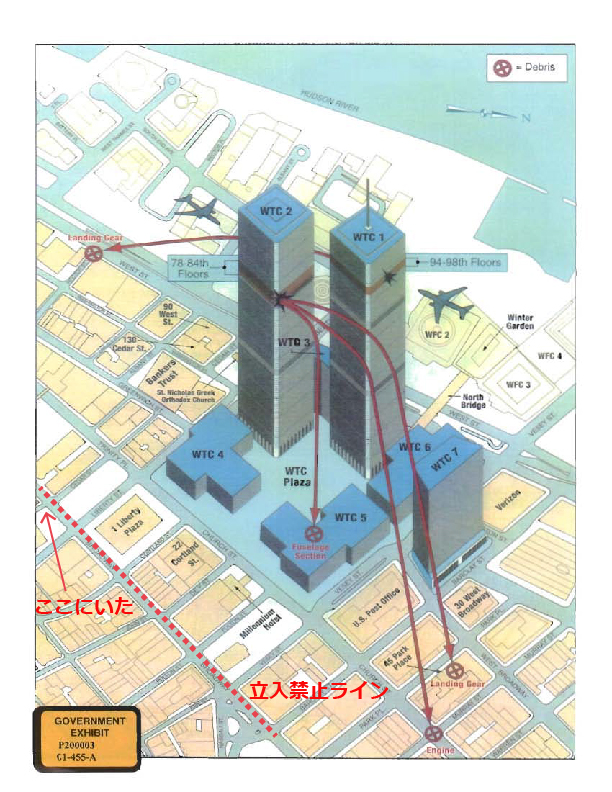
これはパノラマでつなげてみた写真のGIFです。

イサムノグチ作のRed Cubeの前は、人であふれていました。当時はまだスマホがないので、皆呆然と立ちすくんでいるしかありません。口を開けて間抜けな表情で燃え盛るWTCを眺めています(自分も含む)。
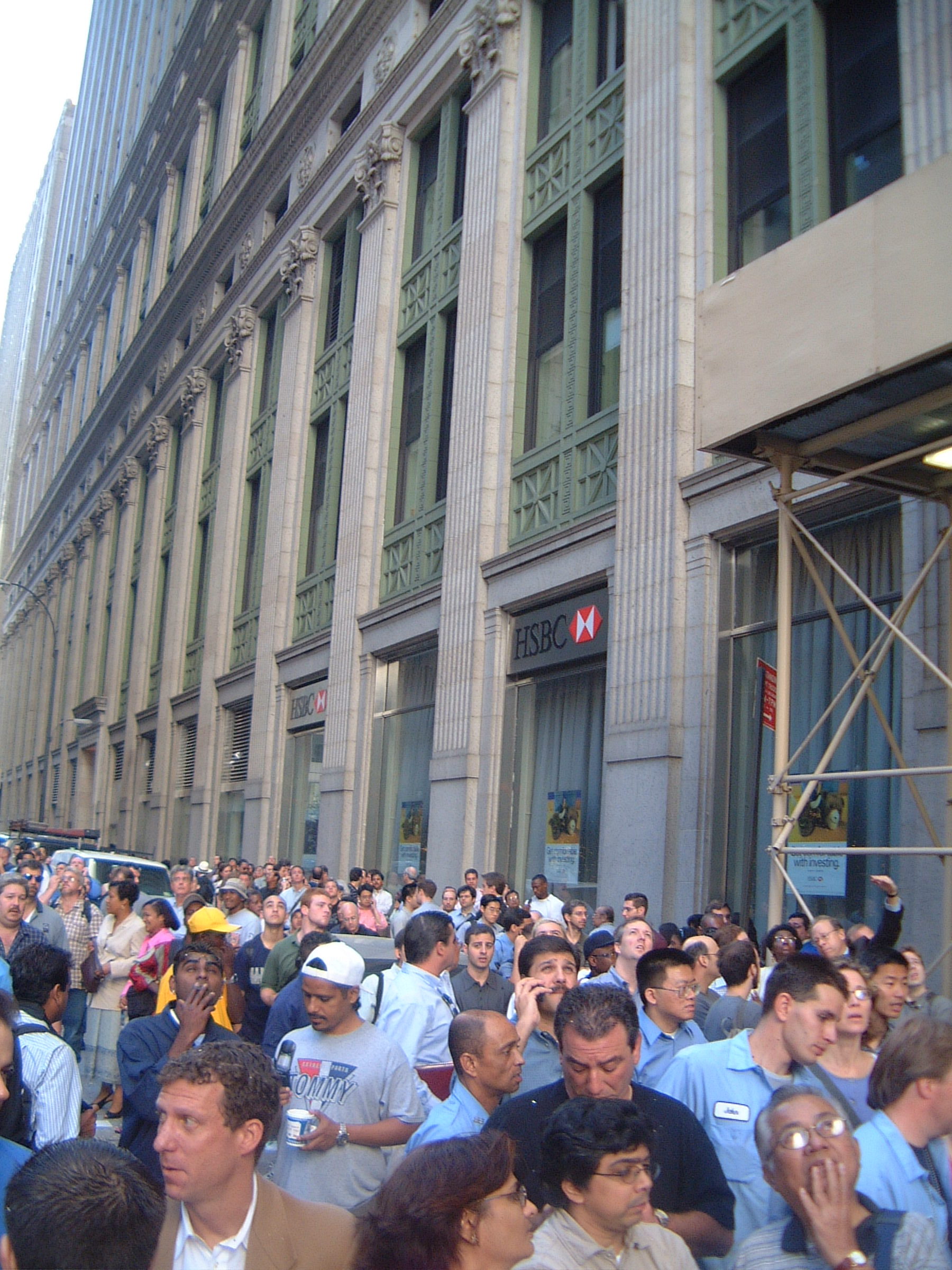
双眼鏡や望遠レンズを装着したカメラを持つ人は「助けを求めて手を振っている人がいるぞ」とか「見ろ、人が飛び降りたぞ!」と口々に叫んでいます(私にはみえませんでしたが)。紙切れや建物外装材の破片が、紙吹雪のように空中を舞いキラキラ輝いていて、とても印象的だったことを覚えています。
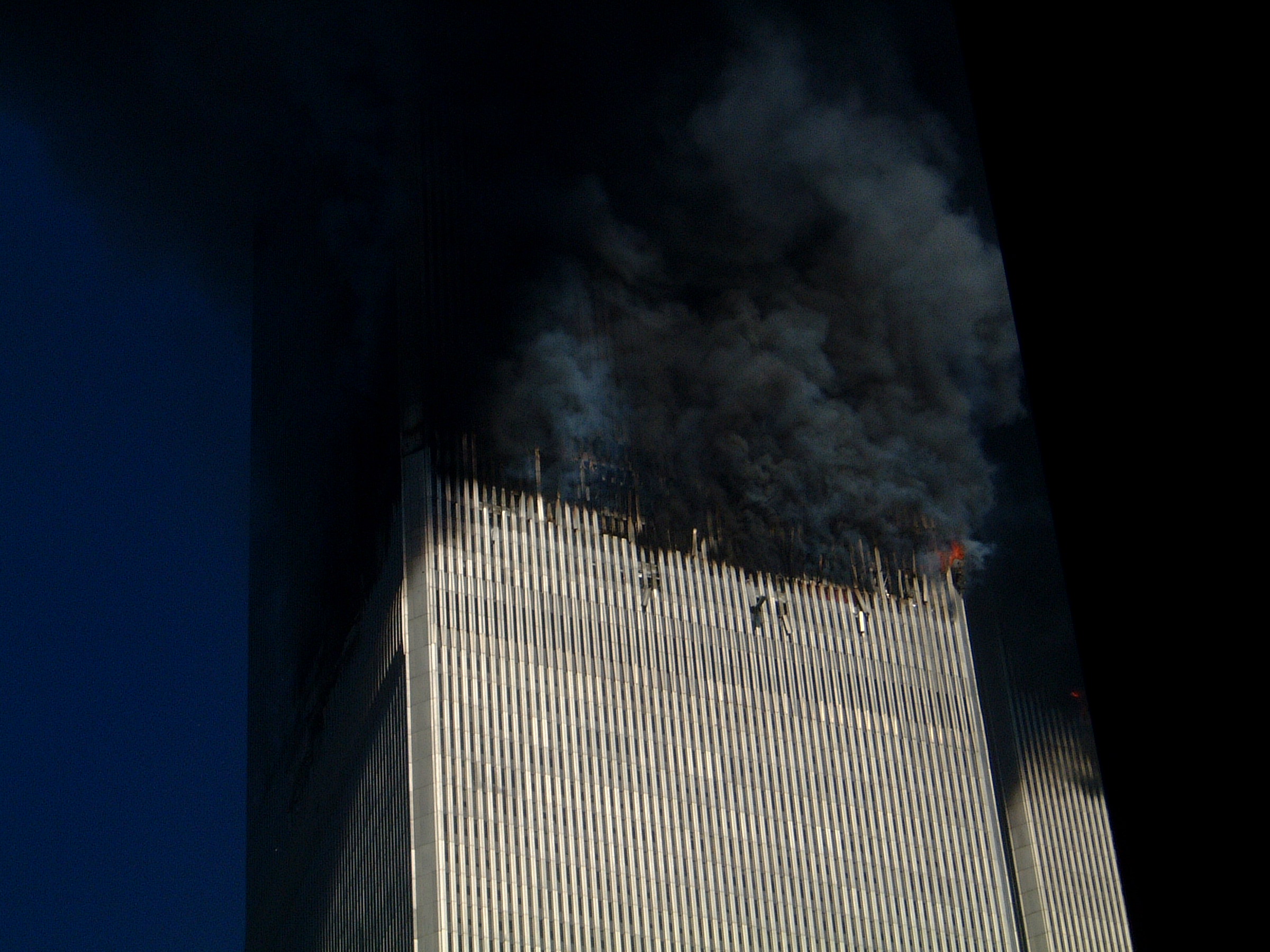
爆音とともに
一通り何が起こっているかを確認し「もうそろそろ職場に向かうか」と考えていた矢先、突然「Oh My God!!!」の叫び声や悲鳴とともに人々が慌てふためき始めました。何が起こったのか最初は理解できなかったのですが、ふと振り返ってみると大きな塊のようなものが
バキバキバキ
という轟音とともにこちらにめがけて襲ってきます。WTCがこちらに向かって倒れてきたのだと思いました。この音を言葉にするのは難しいのですが、「何百台ものダンプカーが鉄板を乗せて悪路を走行しているような音」とでも表現すればよいのでしょうか。当時よく遠くから砂埃に追いかけられる映像が放映されていましたが、自分の場合は、ほぼ真上から砂埃や建物の破片が降ってきたことになります。
このような危機的状況にあると「人生が走馬灯のように巡る」と人は言います。私の場合は特にフラッシュバックがある訳でもなく何かに祈る訳でもなく「このまま死ぬのかなぁ」と漠然と感じていたことを記憶しています。圧倒的な無力感です。
同時に「まずは身を隠さなければ」と本能的に判断し、すぐそばのHSBCの仮設足場の下に隠れ、頭を下げてうずくまりました。当時まだ若かったからでしょうか、非常事態にとっさに体が反応したようです。

爆音が1,2分続いたような気がします。砂埃が体を打ち付けます。息をしようとしても、砂が口に入ってきてなかなかうまく呼吸ができません。海で波にのまれて、息をしようとして口を開けても、空気ではなく海水が入ってくるような感じです。
2,3分経過したでしょうか、ただただ息をひそめてじっと耐えていると、急に静かになりました。あたりを見回すと砂埃で何も見えません。HSBCの窓ガラスも爆風で粉々に割れています。
そのうち、パッと街灯に明かりがともりました。明るさを検知するセンサーが作動したからでしょう。
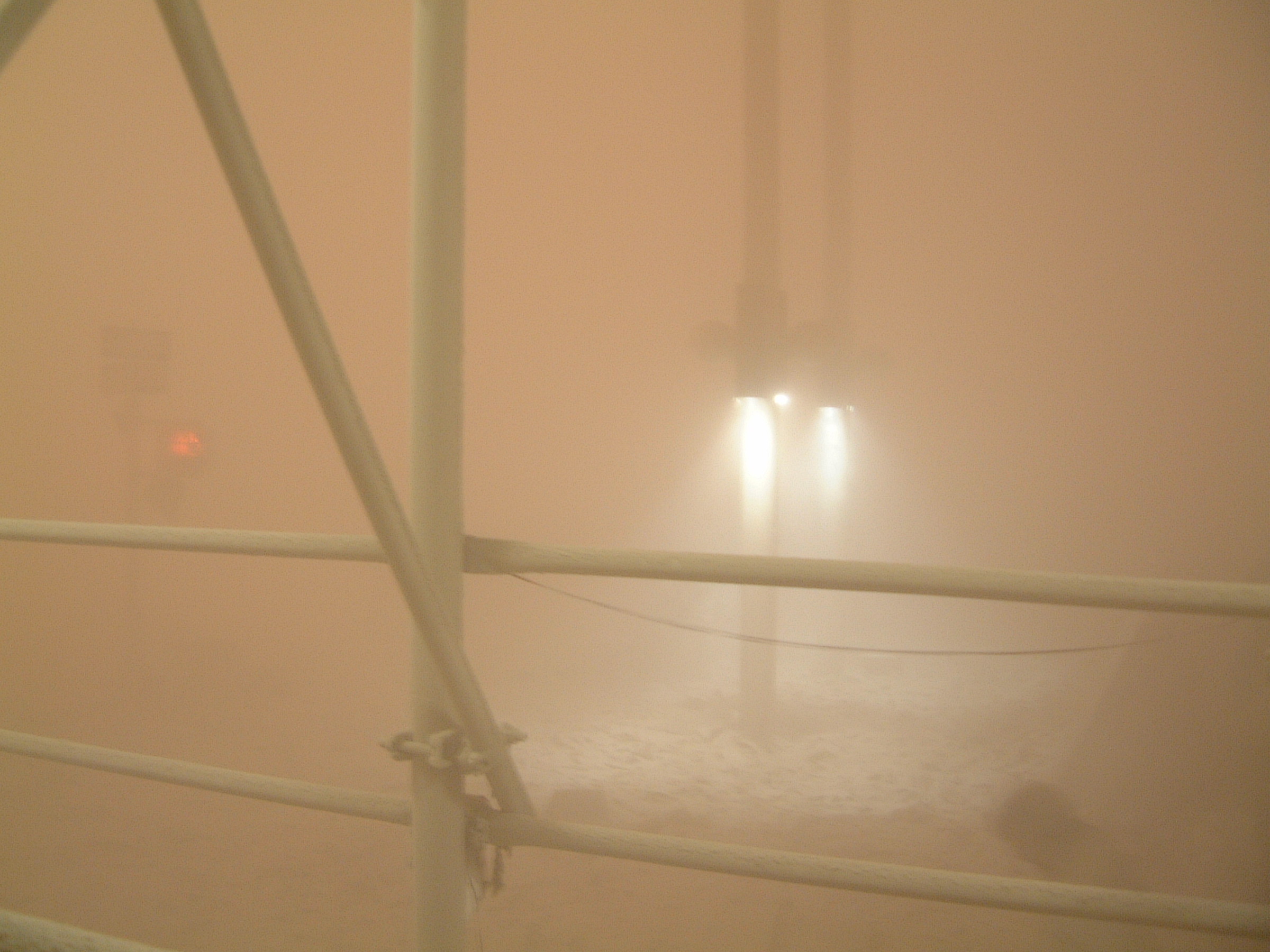
あたりを見回すと、信号も何もなかったように作動しています。
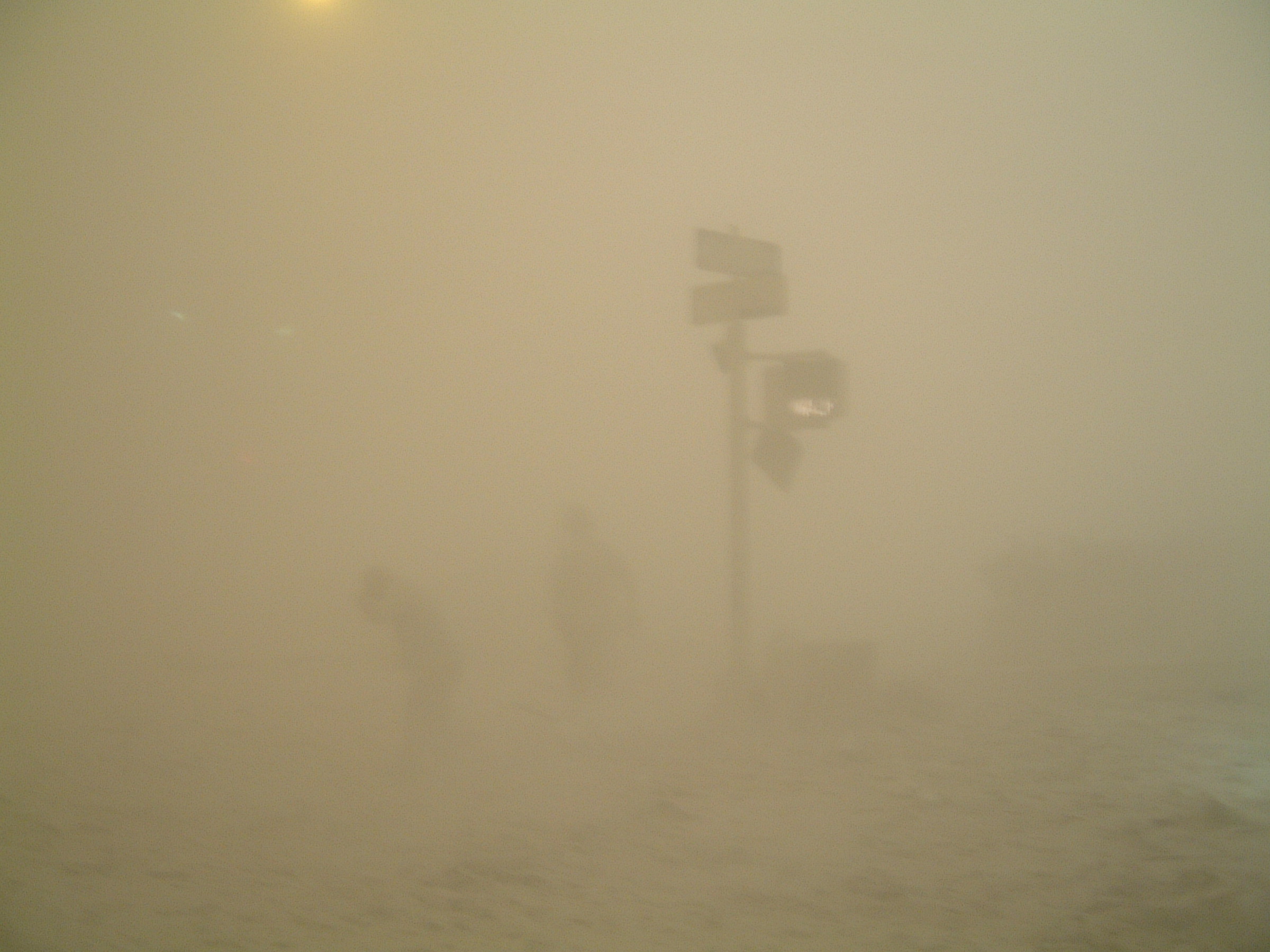 白い静寂の中、照明がともる光景はとても美しいものでした。しんしんと雪が降る夜のスキー場で、ナイター照明が粉雪を照らしている光景を思い出していました。
白い静寂の中、照明がともる光景はとても美しいものでした。しんしんと雪が降る夜のスキー場で、ナイター照明が粉雪を照らしている光景を思い出していました。
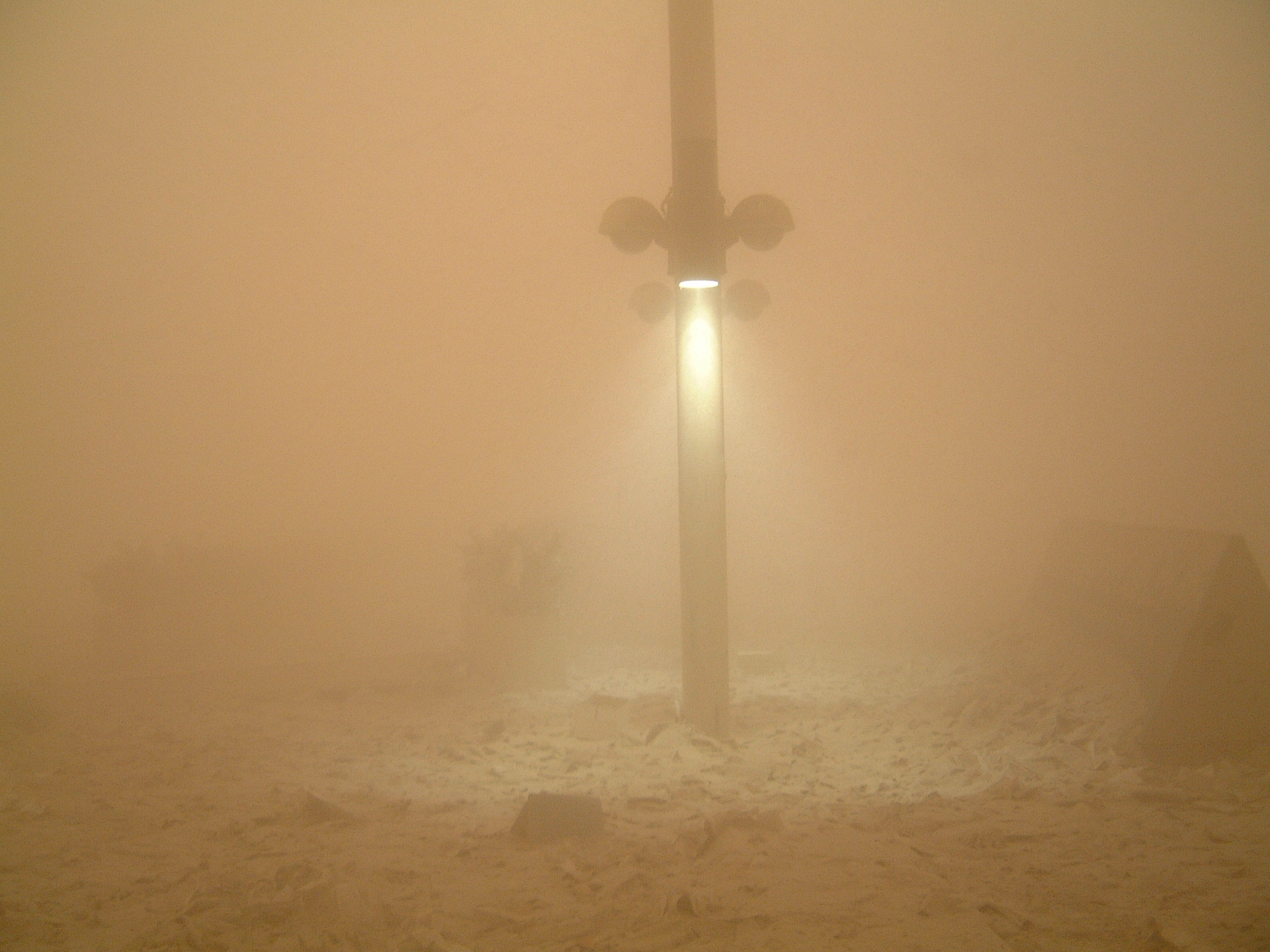 この世のものとは思えない爆音と、その後に起こった静寂との対比が、強く印象に残りました。
この世のものとは思えない爆音と、その後に起こった静寂との対比が、強く印象に残りました。
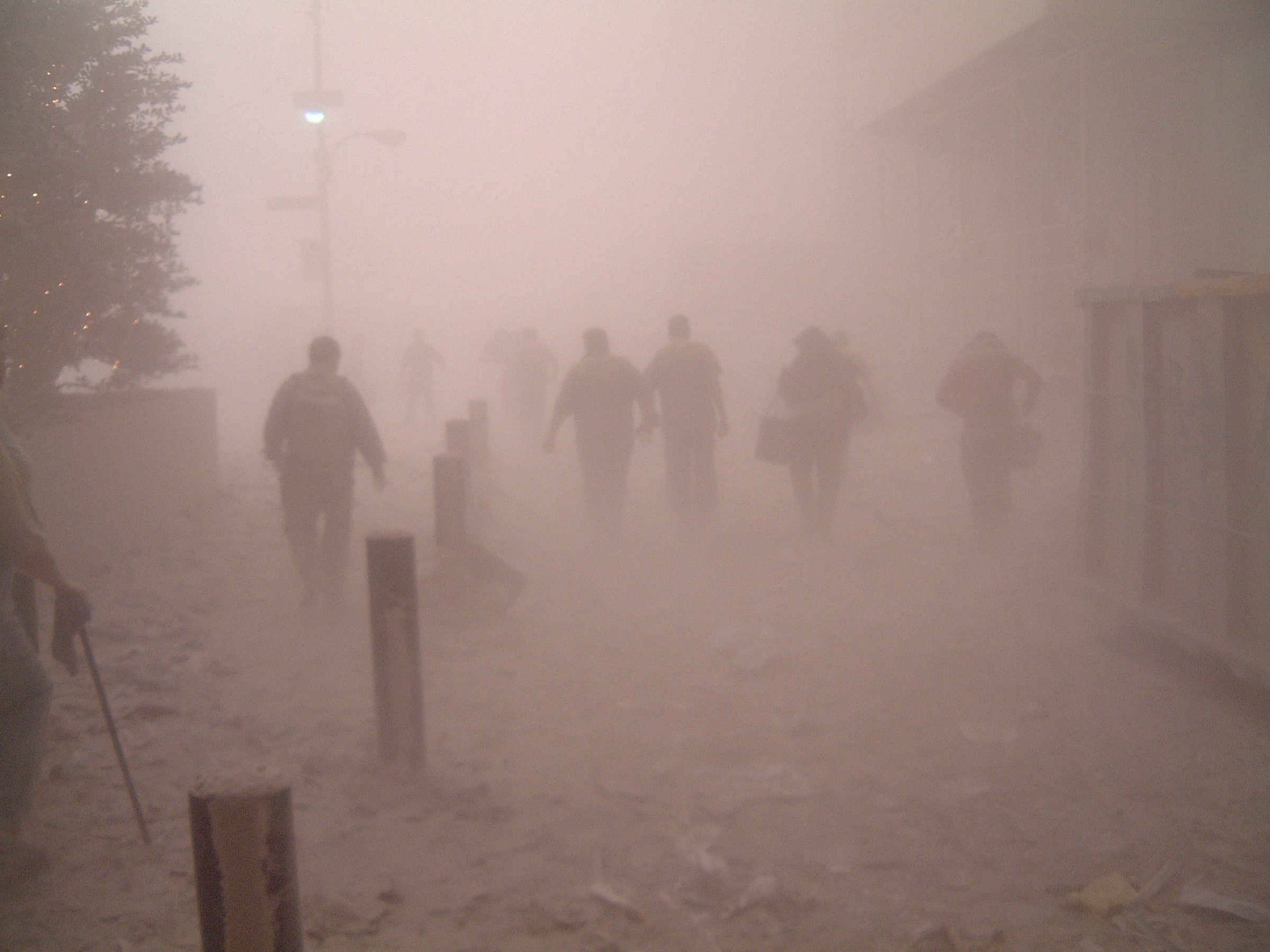 人々はようやくよろよろと立ち上がり、職場へと向かいます。みな粉塵にまみれ真っ白で、ドリフのコントのようです(ちょっと古いかな?)。
人々はようやくよろよろと立ち上がり、職場へと向かいます。みな粉塵にまみれ真っ白で、ドリフのコントのようです(ちょっと古いかな?)。
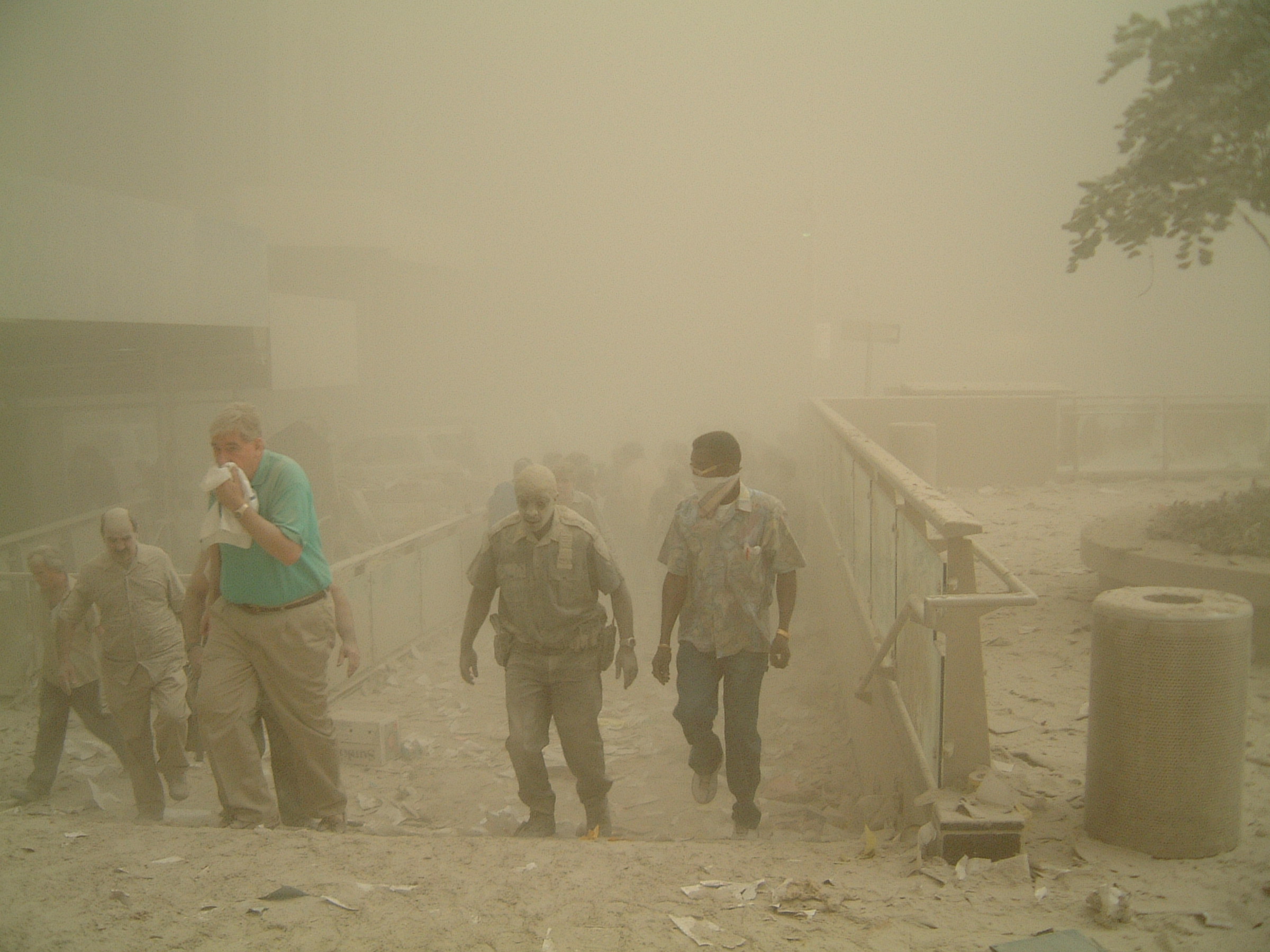 私もこの写真中央の男性と同じくらいに、全身粉塵まみれでした。
私もこの写真中央の男性と同じくらいに、全身粉塵まみれでした。
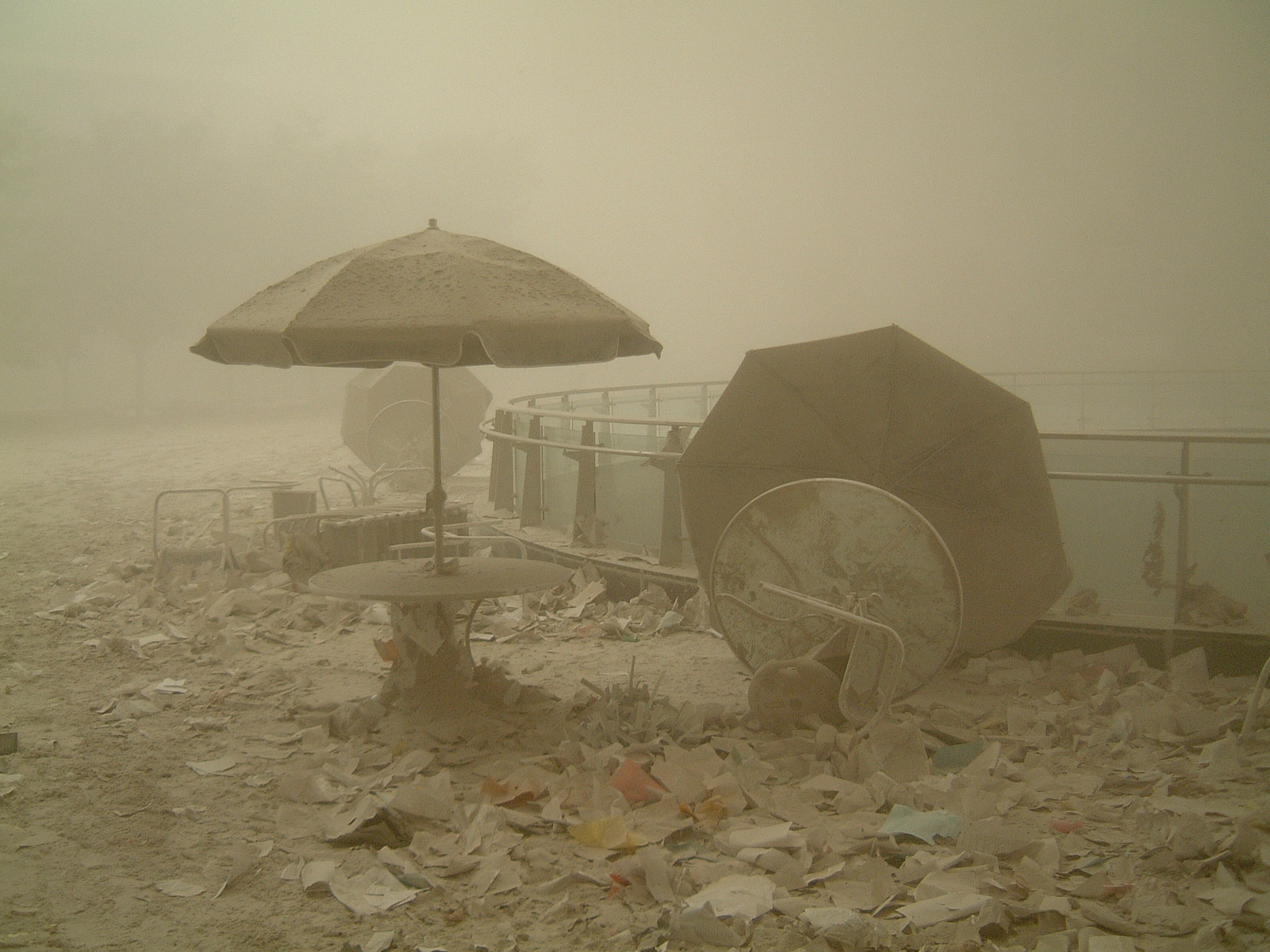 数ブロック離れたところでも、パラソルが倒れています。爆風の強さが良くわかります。周囲は紙くずだらけでした。
数ブロック離れたところでも、パラソルが倒れています。爆風の強さが良くわかります。周囲は紙くずだらけでした。
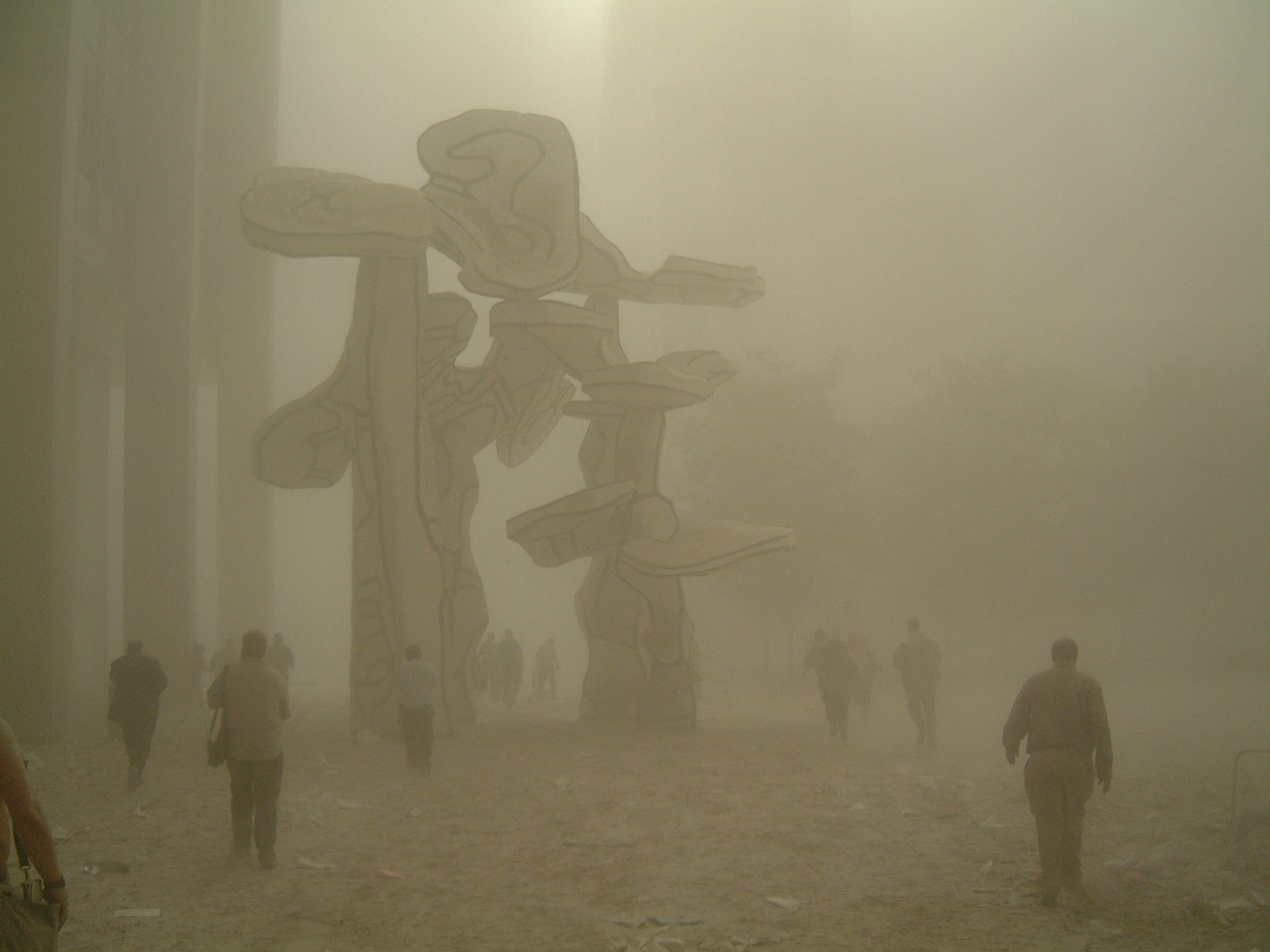 Jean Dubuffetによる Group of Four Treesの彫刻が、WTCと職場の間にありました。砂埃だらけの人々と、この彫刻の対比がシュールです。こうしてトボトボと歩いて事務所に向かいました。
Jean Dubuffetによる Group of Four Treesの彫刻が、WTCと職場の間にありました。砂埃だらけの人々と、この彫刻の対比がシュールです。こうしてトボトボと歩いて事務所に向かいました。
ようやく事務所にたどり着く
砂埃をあびて真っ白になりながら事務所に入ると、「Masaだいじょうぶだったか?」と口々に声をかけられました。いろいろな人に「現場でのんきに見物していたとはなんてidiotなんだ」と罵られながらも、「生きていてよかったね」と皆心配して声をかけてくれました。当時自主判断で出社を取りやめた人も多く、半分以下の人のみ出社していたと記憶しています。
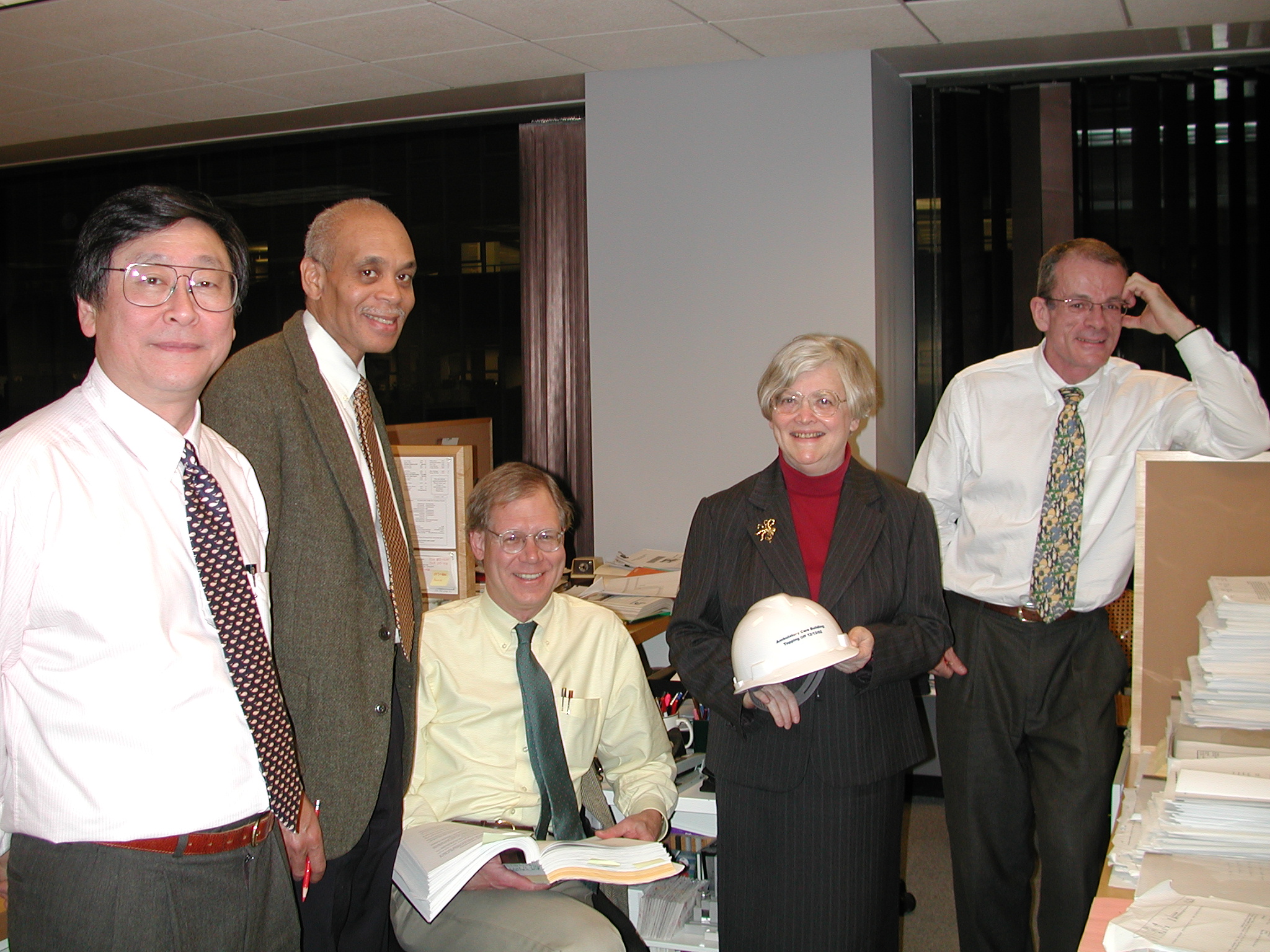
まず真っ先に洗面所に行きました。うがいを何度もします。鼻の中を何度も洗います。そしてコンタクトをしている目を何度も洗いました。清潔な水がふんだんに使えることは、とてもありがたいことでした。
その後、当時ワシントンDCに住んでいた妹にすぐ電話をしました。このような非常事態で、電話がすぐにつながらなくなることが予想されたからです。国際電話であればなおさらつながりにくくなっていたでしょう。まずは生きていて無事であることと日本にいる両親に連絡することを手短に伝えました。
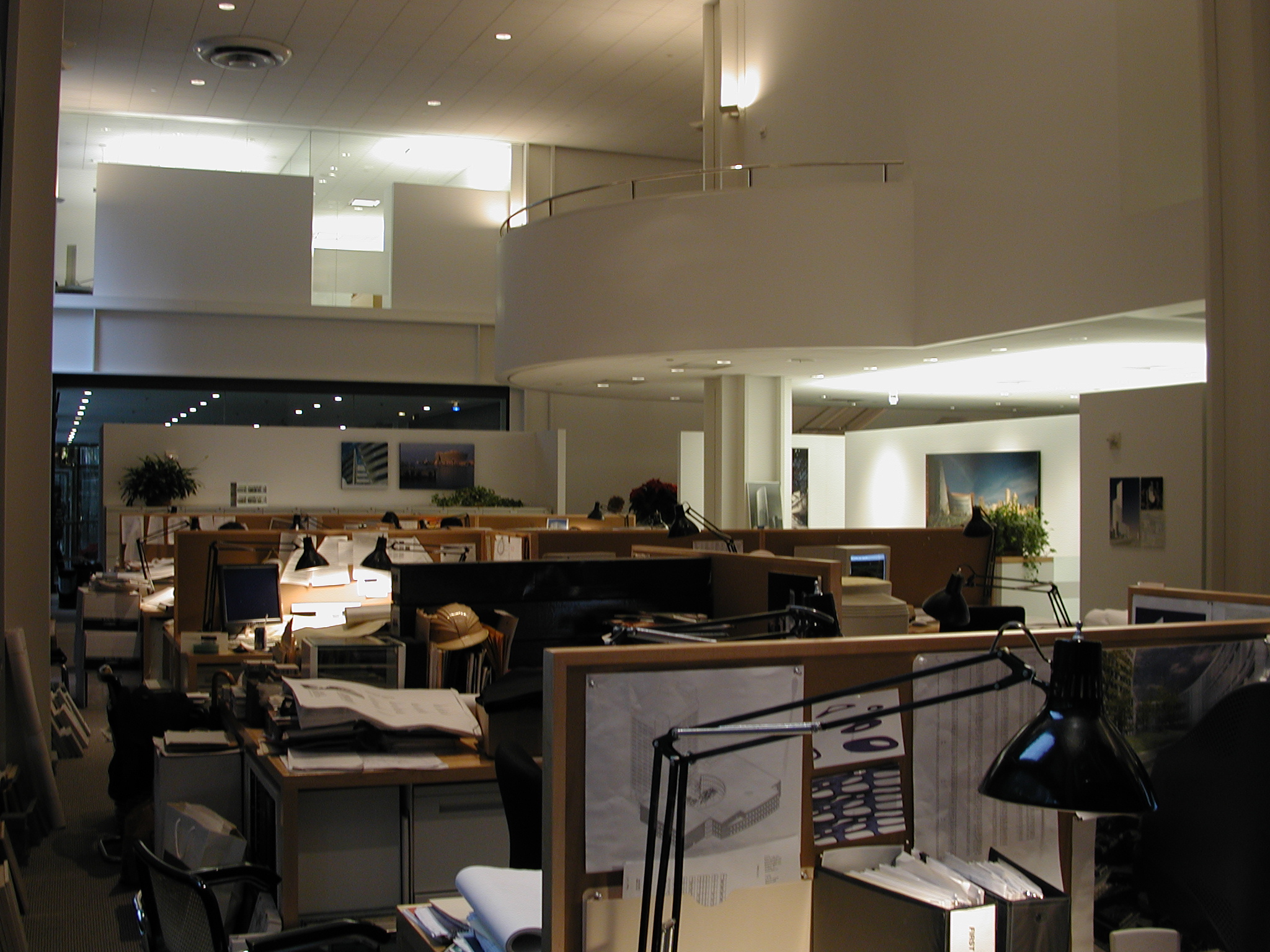
するといきなり、遠くから悲鳴とも嗚咽ともつかない声が聞こえました。そのとき丁度、WTCの2本目のタワー(タワー1)が倒壊したのです。その時まで「あれだけすごい衝撃だったので、タワーが2本同時に倒壊しただろう」と思っていたのですが、実は私が遭遇したのはタワー2の崩壊だけであったことが、その時初めて分かったのでした。
家路へつく
当然このような状況ですから、事務所は休みです。マンハッタンのダウンタウン・エリアの公共交通機関はすべてストップしており、歩いて帰ることになりました。周りを見回すと、不安そうな表情で家路につく人々がたくさんいました。
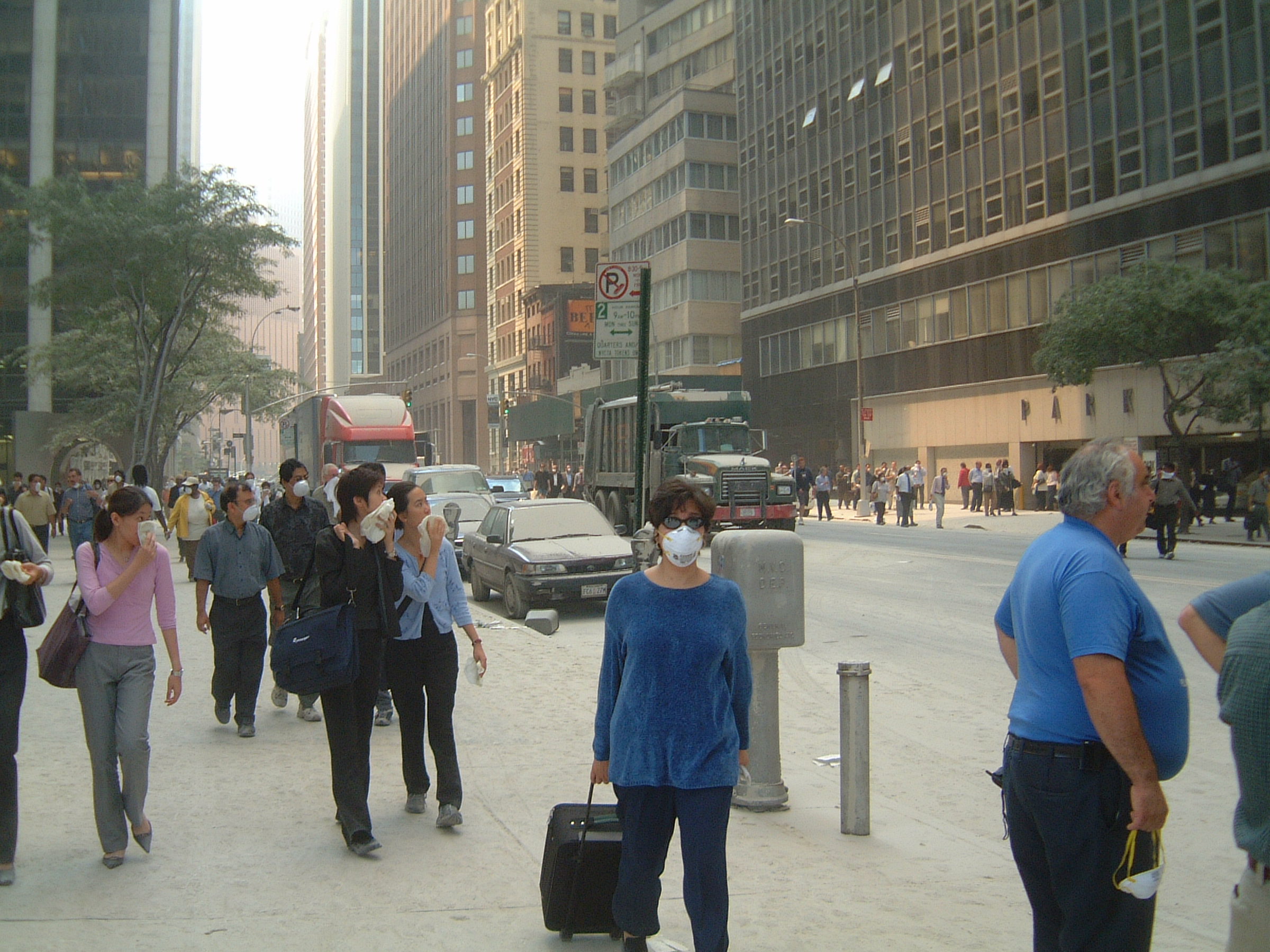
ふとWTCを振り返ると、青い空の下、粉塵が立ち上がっています。この時は、いったい何が理由でWTCが倒壊したのか、全くわかっていませんでした。
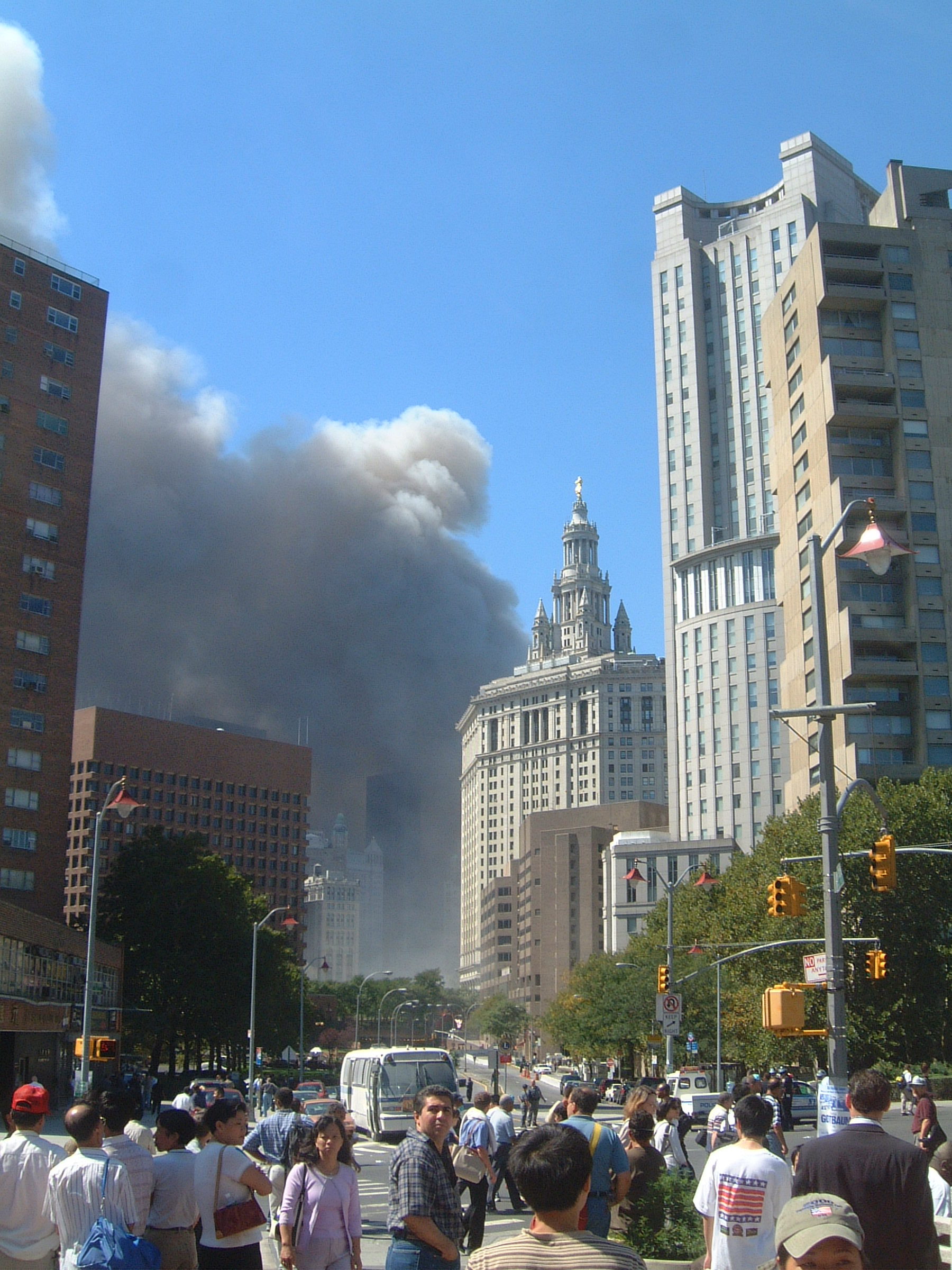
職場から自宅まで、歩いて1時間ほどです。この時は、歩行可能な距離に住んでいて本当に良かったと思いました。
家についてから
帰り際に、水やオレンジジュースを数日間分を買い込みました。家に着いたときは、まだWTC崩壊直後の影響で活性化していましたが、精神的にも肉体的にも疲れ果てていたのだと思います。シャワーを浴び、布団に潜り込みました。ほぼ1週間、眠くてたまらず、水分補給とトイレに行くこと以外ずっと昏睡状態でした。
1週間がたち、ようやく起き上がれるようになった時、不思議なことに、何が起きたか細かいことを忘れていました。自分では意識していませんでしたが、強い精神的なショックがあったために、記憶を忘却するメカニズムが働いたのかもしれません。
どのようにして情報を得たのかわかりませんが、とりあえず職場のあるダウンタウンは2週間ほど封鎖されると聞きました。職場の同僚やNYに住む友人たちの安否もわからないまま、ごろごろして過ごしていたのですが、時折、戦闘機が上空を旋回していた音が聞こえ、何とも言えない気分になりました。
1か月ほどして
1か月ほどしてから現地に行きました。WTCの崩壊当時、この足場の下に隠れていた訳です。粉々に割れた窓ガラスは、ベニヤ板でふさがれていました。何かしらの破片が自分に直撃する可能性もあったことを考えると、この仮設足場をこのように落ち着いた状況で見るのは、今となってもとても複雑な心境です。
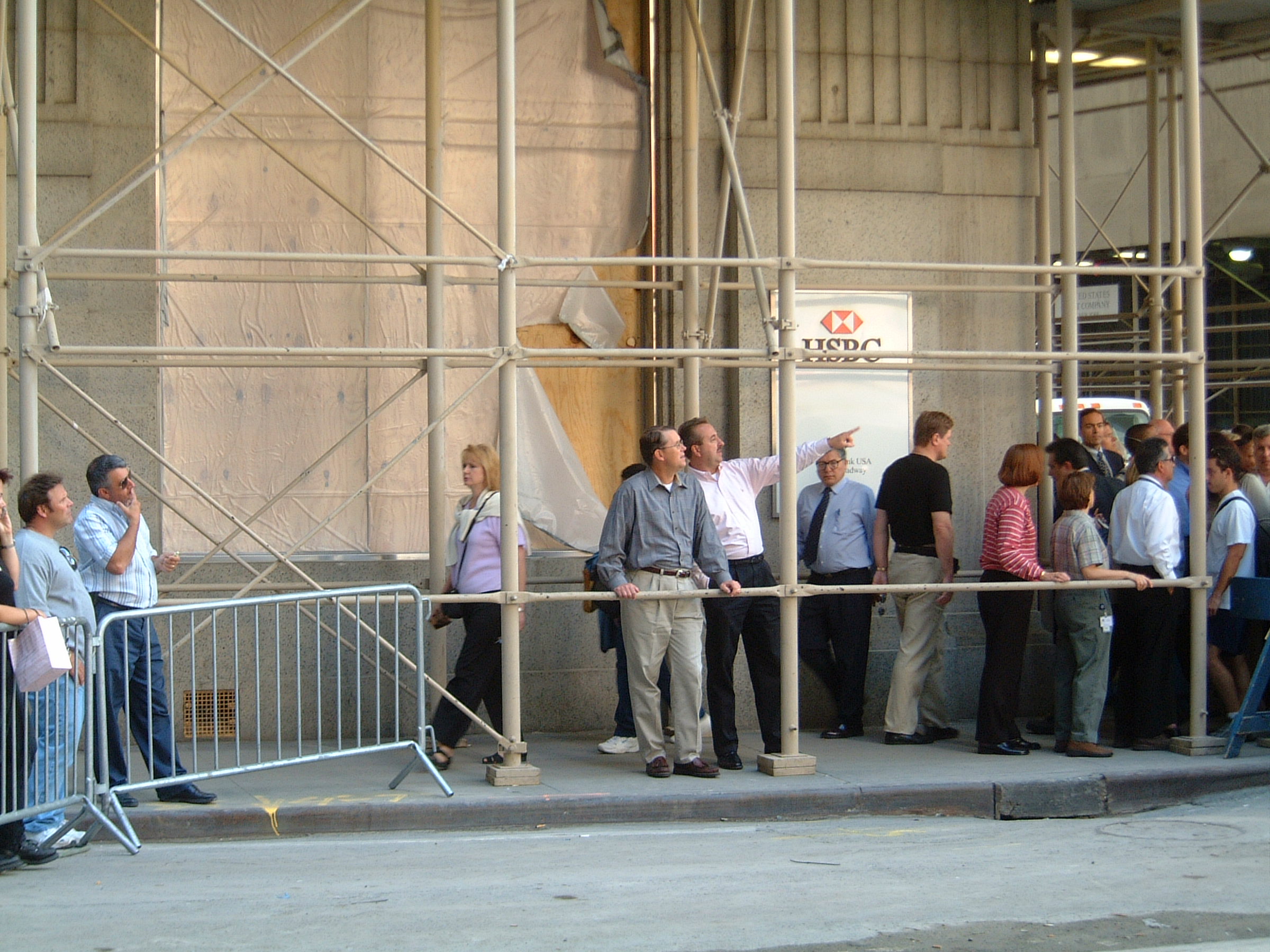
まだ現地からは粉塵が立ち上っています。WTC崩壊当時と一緒で、Broadwayより先は立入禁止でした。既に解体作業が進んでいたからでしょうか、ワールドトレードセンターは跡形もありませんでした。遠くに作業用のクレーンと崩壊したWTCの1階部分の残骸が見えます。

よく見てみると、ワールドトレードセンターの特徴的なカーテンウォールの残骸が見えます。構造体の鉄骨が露出しています。
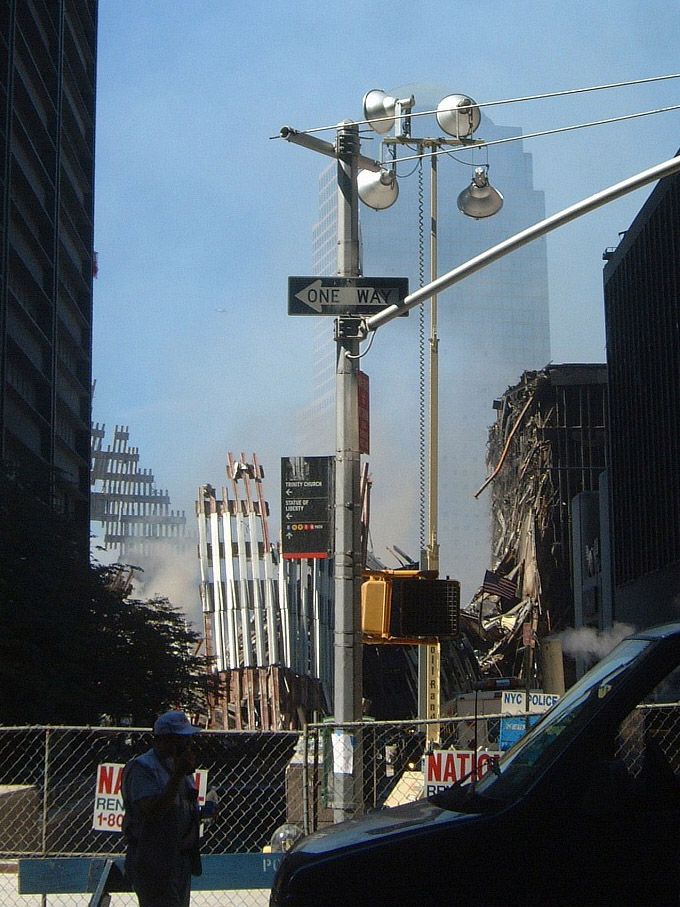
WTC崩壊直後、NYでは犠牲者を悼むとともに、国として団結を促す空気を強く感じました。次のテロを警戒し、戦闘機が絶えず上空を飛んでいましたし、いたるところにアメリカの国旗が掲げられていました。NYSE(ニューヨーク証券取引所)では、ファサードにアメリカの国旗が掲げられていました。攻撃されたWTCとともに、NYSEもアメリカ資本主義社会の象徴でです。
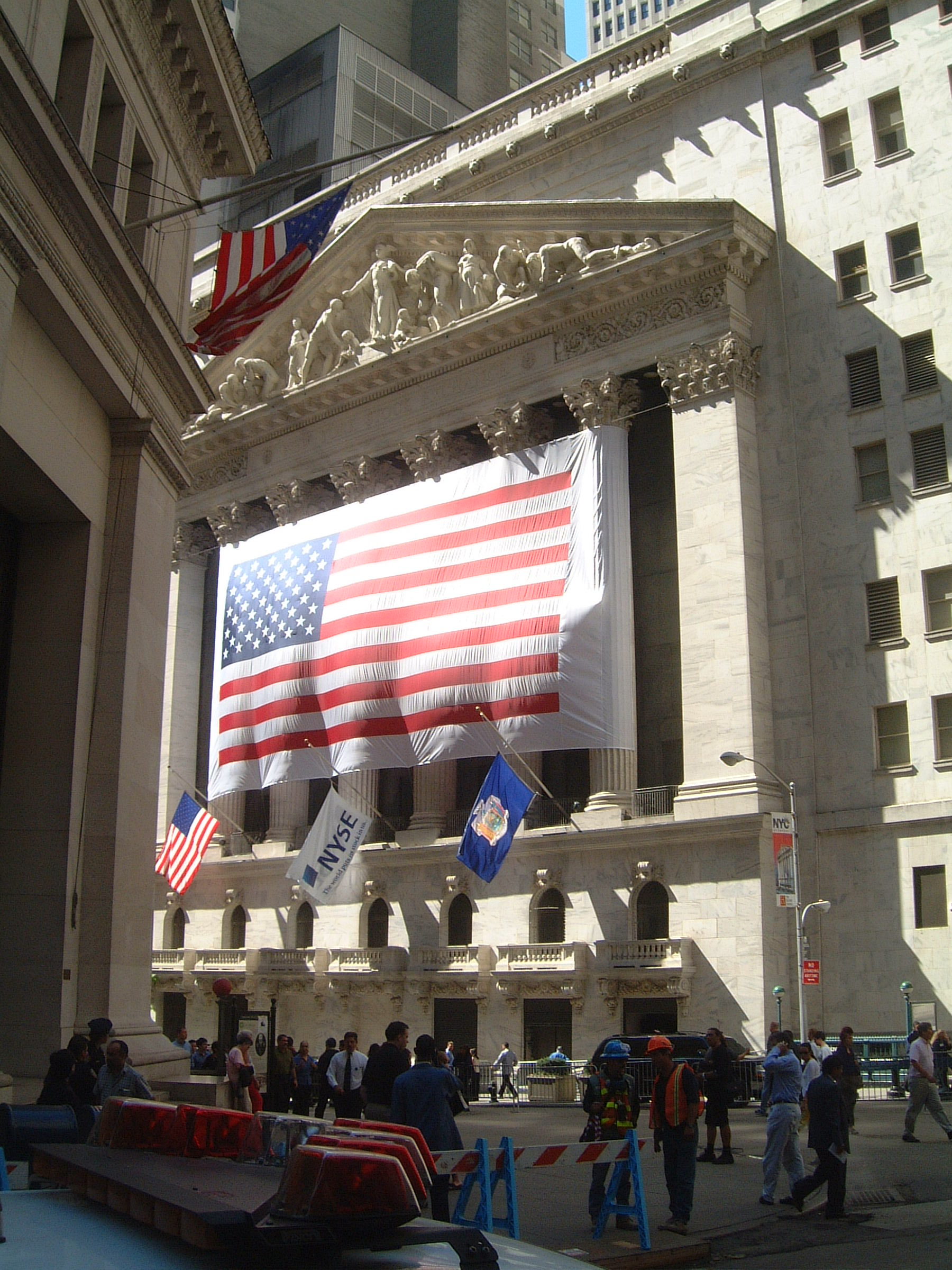
またWTC崩壊直後、周辺の店舗では略奪行為が発生したとも聞きます。店舗のガラスが爆風で割れたのか人為的に割られたのか分かりませんが、砂埃が店の中に入ったままで、営業開始までは程遠い状況です。アメリカ国旗をプリントしたTシャツが掲げられていたのが印象的でした。

それから後は、ナショナリズムと反イスラムの空気が米国を蔓延することになります。特にテロ直後の数日間にニュース報道は、飛行機がWTCに突っ込んでいく映像を数分おきに繰り返し流し、ただただ感情的なコメントを述べていました。私はイスラム系ではないとしても、米国にいる外国人の一人として、いままで見たことがない米国の一面を見た気がしました。1か月ほど経つと、ようやく当初の感情的な報道とは多少異なる姿勢の、やや広い範囲からの報道がなされるようになりました。ウサーマ・ビン・ラーディンは2011年に殺害されましたが、和平はいまだに達成されず解決からは程遠い状況です。遠い中東の紛争として考えていたことが、こうしてわが身に降りかかった出来事として関係していると、いまだに他人事とは思えません。
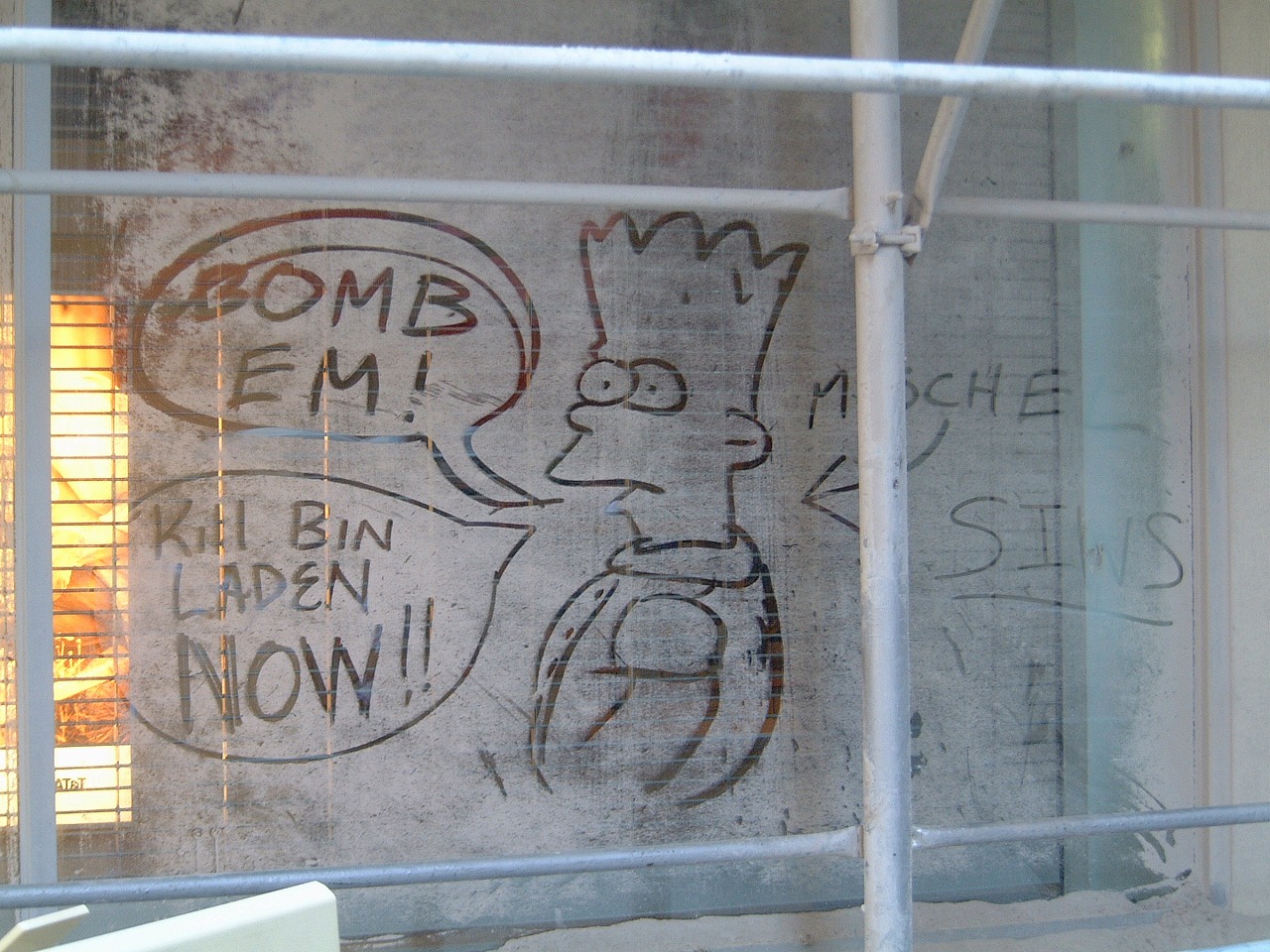
人の感覚とは不思議なもので、現場周辺を訪れたり写真を見たりしても、恐怖や悲しみを感じることはほとんどありませんでした。しかし、事故から1、2年くらいまでは、ダンプカーが発するガチャガチャとした音を耳にしたり、ゴムや「何か」が焼けたような匂いが漂ってきたりすると、背筋に悪寒が走り鳥肌が立ちました。視覚よりも聴覚や嗅覚の方が、記憶と結びつきやすいのかもしれません。18年も経った今では、特に何も感じなくなりましたが。
幸い、同僚や友人の中で亡くなった人はいませんでしたが、知り合いの知り合いでは、亡くなったりケガをされたりした方の話を聞きました。ご冥福をお祈りいたします。
学んだこと
大学・大学院と建築を学び、WTCの至近距離にある建築設計事務所に勤務し、実際に建物内にも訪れていながら、あのような状況下でWTCが崩壊するとは夢にも思っていませんでした。恥ずかしい限りです。後から崩壊するメカニズムを放映しているのを見て「なるほど」と理解することはできたのですが、その場に居合わせた時には、崩壊するという予測をすることができませんでした。
ここで学んだ最大の教訓は
危険な場所には近づかない
ということです。冷静に考えれば、当たり前のことですが、「火事場見物」したくなる心理は誰にでもあります。というか、自分にはありました。
最初から危険であることが分からない場合もあるでしょう。しかし、危険なことに巻き込まれる可能性があると、日常的に直感や想像力を働かせて危機管理をする必要があるのです。特に、生まれてから自国内で紛争や戦争に巻き込まれることがなかった自分のような環境であればなおさら、危険を感じる感覚を意識して養っておくことは大切だと思います。
WTCは人災です。しかし、現在日本では、台風や地震など、自然災害が相次いで発生しています。こうした災害時に、SNS等にアップすることを目的として、動画や写真の撮影のためあえて危険な場所に近づく人も多いのではないでしょうか。
勢力の強い台風では、事前に公共交通機関が運転を休止し、学校も休校となり、会社によっては休みのところもあると聞きます。危機管理の一環として、あらかじめ休みとすることは、ついつい登校・出社しがちな生真面目な日本人に対して、とても大切なことだと思います。ちなみに、このWTC 崩壊にあたっては、当時自主判断で出社を取りやめた人も多く、半分以下の人のみ出社していたと記憶しています。このように一歩進めて、自分の頭で考えて自己判断ができるようになると、さらに良いと思います。危機的な状況下で、来るかどうかもわからない指示を待っていることは、リスクと考えられるからです。
「危険な場所に近づかない」を拡大解釈すると「危険に近づかない」です。世の中は「危険」であふれています。「危険な人」がパワハラしてくるとか、「危険なモノ」(例えば自動車)が想定外の動きをするとか。「危険」が避けられないとするならば、その時にどんな風に行動するのか、どんな逃げ方があるのか等々、シュミレートしておくことが大事なのです。
こうしてNYでの修業時代を経て、ニューヨーク州登録建築家と日本の一級建築士の資格を取得し、現在は東京都文京区で建築設計事務所を営みつつ、東京電機大学の教員として教鞭をとっています。よろしければ 【保存版】家を「設計事務所/建築家」に依頼して建てるまでの流れについて説明します もご覧ください。
Twenty years ago, I was there.
That day, I witnessed the Tower 2 of the World Trade Center, the first of the twin towers, collapsed. In this blog, I would like to revisit and document my recollection of what I had learned back then at the site before they call it “Grand Zero.” I took all the photos used in this blog at the time.
THE FOLLOWING ARTICLE MAY CONTAIN GRAPHIC and DISTURBING IMAGES
READER discretion is advised.
WORKING AT AN ARCHITECTURE FIRM IN NEW YORK
In 2001, I worked at Pei Cobb Freed and Partners, an architectural firm in New York, for a little over a year after graduating from Harvard Graduate School of Design (GSD) in Boston. Blessed with good colleagues and seasoned supervisors, I enjoyed the days as a novice architect.

Many of my fellow architects are of Chinese descent, attracted by the Pritzker winner Chinese-American architect I M Pei. In the photo, from right to left, there is a combination of Taiwanese, me (Japanese), Singaporeans, Chinese, Hong Kongers, and Chinese-Americans. Needless to say, the official languages were English and Chinese (Mandarin).

When I don’t have proposals to work on or deadlines to meet, I get off work around 7:00 pm most days. After work, I had a lot of fun going out for drinks, gallery openings, listening to live music and movies, and so on—typical single (bachelor) life in the city. If I had started working in Tokyo, none of these things would have been possible.
My office was on 88 Pine Street, less than a 10-minute walk from the WTC.
I often went out with my co-workers for lunch. One lunchtime perk was the New York Restaurant Week, as many high-end restaurants offered meals at more affordable prices during the event.

This photo was taken one of such days, on February 1, 2001
I had lunch with my colleagues at Windows on the World, the restaurant on the 106th and 107th floor of the North Tower (Building One) of the WTC. It was always packed with Wall Street power broker types of business people and, of course, tourists from all over the world.
 The restaurant also had a great view, as its name suggests. In the photo above/below, you can see the Brooklyn Bridge, Manhattan Bridge, and further back, the Williamsburg Bridge.
The restaurant also had a great view, as its name suggests. In the photo above/below, you can see the Brooklyn Bridge, Manhattan Bridge, and further back, the Williamsburg Bridge.
The view from the 106th floor was indeed exceptional. Once, someone told me that even on a deep cloudy day, you could see the sun on the 106th floor, utterly different from the weather on the ground. I have no way of knowing this now, though.
When we were enjoying our lunch together, we had no idea that the twin tower would become a target of the terrorist act.
WAKING UP IN THE MORNING OF SEPTEMBER 11, 2001
On September 11, 2001, I woke up as usual and got ready to work. I lived in Clinton Hill in Brooklyn, near Pratt Institute, a fine arts college. The apartment is only a block away from the Clinton-Washington Avenues station on the G line, a minor subway line back then (not anymore, perhaps). It took 40 minutes to get to the office in downtown Manhattan.
 The first thing to do in the morning was to turn on NY1, a local news station. I didn’t realize the particular importance or urgency when the newsperson claimed, “There’s a fire at the WTC. I didn’t pay much attention to it, thinking it was probably just a minor fire and would be extinguished soon. I rubbed my sleepy eyes and hopped in the shower. It was just another morning.
The first thing to do in the morning was to turn on NY1, a local news station. I didn’t realize the particular importance or urgency when the newsperson claimed, “There’s a fire at the WTC. I didn’t pay much attention to it, thinking it was probably just a minor fire and would be extinguished soon. I rubbed my sleepy eyes and hopped in the shower. It was just another morning.
When I got out of the shower, my television was not working. I wondered if the it was broken, but then again, I didn’t pay much attention and got ready for work. Later I learned that an antenna for television broadcast was on the roof of WTC. The fire must have damaged it and caused the TV disruption.
ARRIVING AT BROADWAY-NASSAU STATION
Many use this station to get to the WTC. As I walked up the stairs, I saw people rushing with commotion. What is it? Everyone was staring in the same direction.

When I turned, WTC was burning in flames. I wasn’t able to resist my curiosity got the best of my sound judgment. Start walking toward the WTC, and I had no idea that it was about to collapse as it did.

On Broadway, I was drawn by the crowd of onlookers, police officers, and news reporters.
 We couldn’t get any closer to the other side because the perimeter was set up with the yellow tape bordering Broadway. If there had been no yellow tape to stop me, I might not have survived nor written this blog.
We couldn’t get any closer to the other side because the perimeter was set up with the yellow tape bordering Broadway. If there had been no yellow tape to stop me, I might not have survived nor written this blog.
The map shows the area here.

This is a GIF of a panorama photo.

The area in front of the sculpture “Red Cube” by Isamu Noguchi was overflowing with people. We didn’t have smartphones back then (unbelievable, eh?). Everyone around me had nothing to do but to stand there in a daze, looking at the burning WTC with mouth opened, or maybe “jaw dropped” was the proper expression.
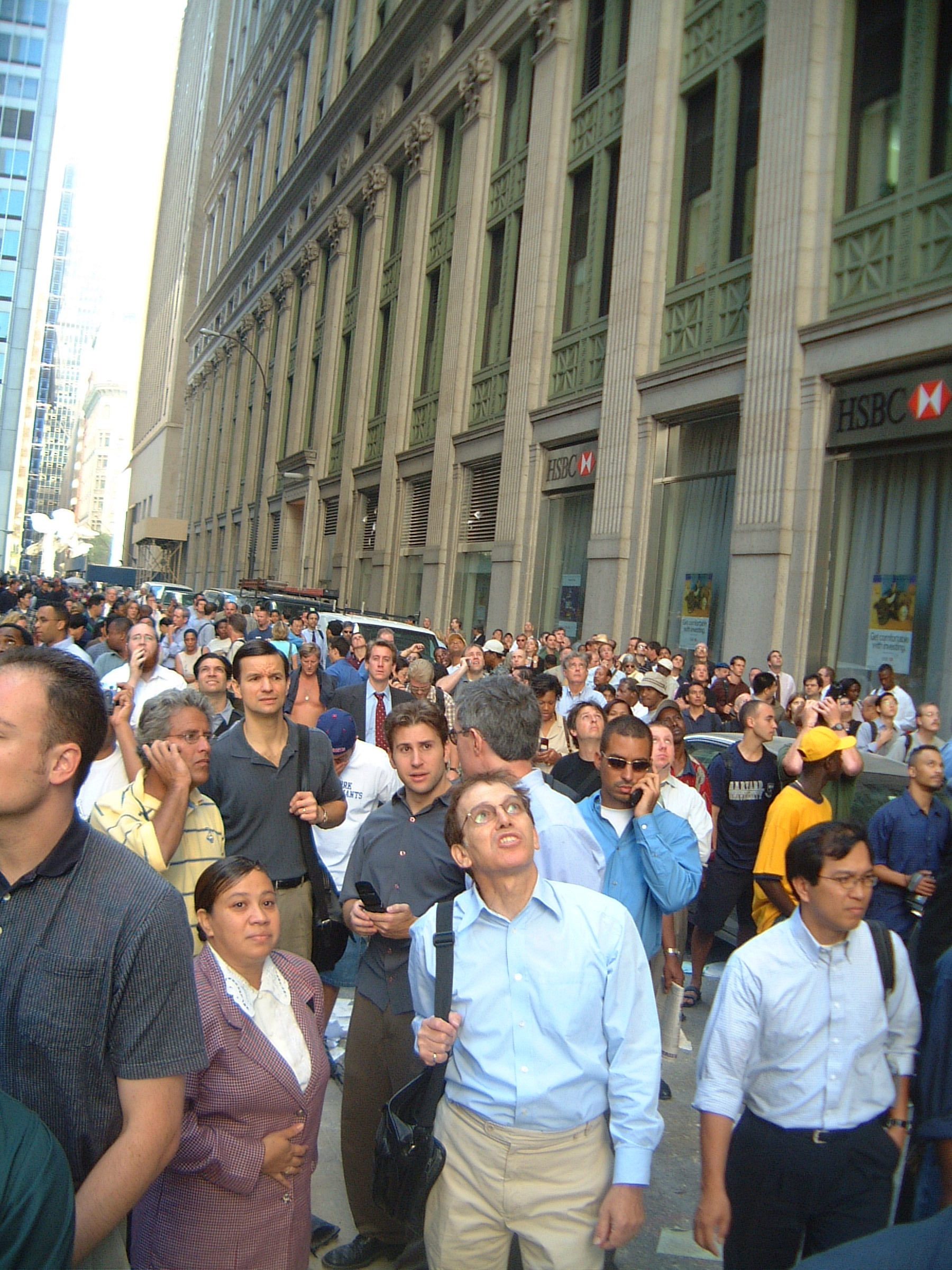
Meantime, those with binoculars or cameras with telephoto lenses were shouting, “A man is waving for help,” or “Someone just jumped!” (I didn’t see it). I remember that pieces of paper and building exterior materials flying and glittering in the air like confetti.

With the sound of the explosion
Just as I came to sense thinking, “I’d better get to work,” I suddenly heard someone yelled “Oh My God! “ People started to panic with shouts and screams of this simple sentence, “Oh My God!” At first, I couldn’t comprehend what was happening, but I saw a big lump of something when I looked back.
Crack, crack, crack!
I thought it was the WTC falling towards me. It was difficult to describe the sound, but the closest was “the sound of hundreds of dump trucks driving down a rough road with steel plates on top. “People being chased by dust from afar” was the commonly shared image back then. In my case, the dust and building debris were falling from almost directly above me.
In a life-threatening crisis, people say, “your life flashes before your eyes.”
I don’t recall anything flashes before my eyes. Instead, it was a vague feeling of “I’m going to die like this.” It was an overwhelming feeling of helplessness.
First, I instinctively ducked to hide under the temporary scaffolding of HSBC nearby and crouched with my head down. Thanks to my youth, my body responded quickly to the emergency.
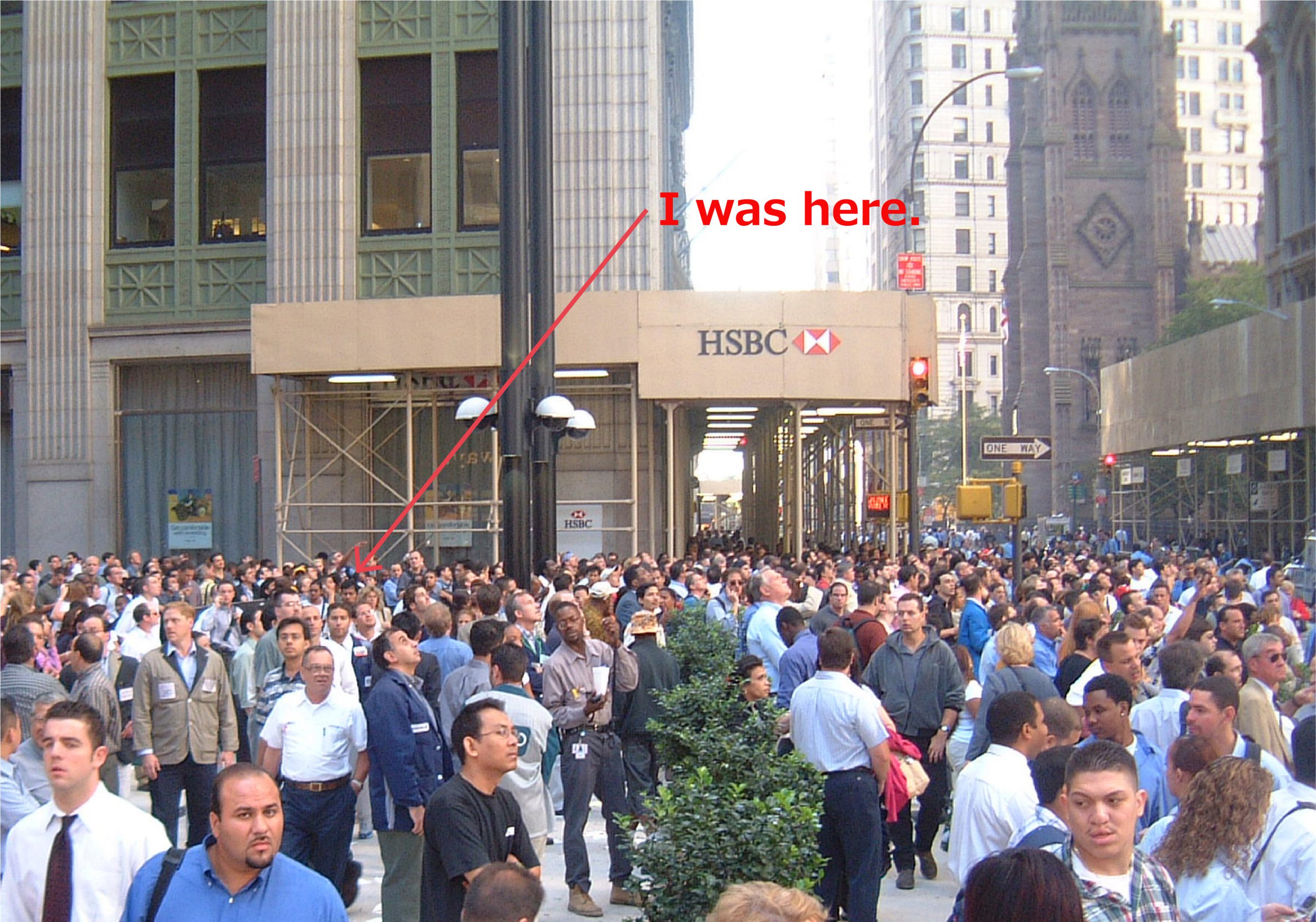
The explosion must have continued for a minute or two. The dust hit my body. I tried to breathe, but the sand was getting into my mouth, and I couldn’t breathe well. It was like being swept up in the waves at sea and opening your mouth to take a breath only to have seawater come in instead of air.
After a couple of minutes, I tried to hold my breath, and suddenly it became quiet. I looked around, but nothing was visible because of the dust. The blast shattered the windows of HSBC.
Then came on a streetlight. I guessed the brightness sensor had been activated.

I looked around and saw that the traffic lights were working as if nothing had happened.

Strangely enough, it was a somewhat “beautiful” sight to see the lights on in the white silence. It reminded me of the scene at a ski resort on a snowy blizzard night, with the night lights shining on the powdery snow.
 The contrast between the out-of-this-world sound of the explosion and the silence that followed left a strong impression on me.
The contrast between the out-of-this-world sound of the explosion and the silence that followed left a strong impression on me.
 People finally staggered to their feet and headed for their workplaces. Everyone was covered in dust and white, looking something out of goofy sketch comedy.
People finally staggered to their feet and headed for their workplaces. Everyone was covered in dust and white, looking something out of goofy sketch comedy.
 Obviously, I was just as covered in dust as the man in the center of this photo.
Obviously, I was just as covered in dust as the man in the center of this photo.

A few blocks away, parasols were falling. You can clearly see how strong the blast was. The surrounding area was covered with paper scraps.

Jean Dubuffet’s Group of Four Trees sculpture was located between the WTC and my office. The contrast between the dusty people and this sculpture is surreal. And so we trudged on to the office.
FINALLY TO THE OFFICE
When I entered the office, white with dust, I was greeted by people asking, “Are you all right, Masa?” They were worried about me not showing up nor called in. Some said, “How idiotic of you,” a justifiable comment considering the recklessness of my decisions. Another said, “You’re lucky to be alive. Indeed, I was.
The interesting thing about the office was that about the half of them decided to stay home. They were not told to do so, but they determined that it was safe to stay. I wonder if in Japan, what might people do under such circumstances. Sometimes it is necessary to take matters into your own hands, so to speak. It is easier to ask forgiveness than permission.

The first thing I did was to go to the washroom. Gargle over and over. I washed my nostrils multiple times. Then I cleaned my contact lenses over and over again. I was very grateful to have access to plenty of clean water.
Afterward, I immediately called my sister in Washington DC. In such an emergency, I knew that the phone would be disconnected soon. If it were an international call, it would have been even more difficult to get through. I spoke with her briefly, informing them I was alive and safe and would contact my parents in Japan.

Suddenly, from a distance, I heard a voice that sounded neither like a scream nor a sob. At that moment, the second tower of the WTC (Tower 1) collapsed. Until that moment, I had thought that both towers must have collapsed at the same time because of the tremendous impact, but it was only then that I realized that all I had encountered was the collapse of Tower 2.
HEADING HOME
Naturally, because of this situation, the office was closed. All public transportation in the downtown Manhattan was halted, so I had to walk home. I was surrounded by many people walking home with anxious expressions on their faces.
When I looked back at the WTC, I saw a cloud of dust rising under the blue sky.

At that time, I had no idea what had caused the collapse of the WTC.

It took me about an hour to walk home. When I had finally arrived at my room, I was happy that I lived within walking distance.
AFTER ARRIVING HOME
On my way home, I bought water and orange juice enough for a few days. When I arrived home, I was still agitated by the immediate aftermath of the WTC collapse, but at the same time, I was mentally and physically exhausted. I took a shower and crawled under the covers of my bed. I have slept through the whole week, only to wake up for drinking water for hydration and to go to the bathroom.
When I was finally able to get up, strangely, I had no detailed recollection of what had happened. I was somewhat trying to cope with the psychological shock from the whole event. Interesting how memory works on such occasions.
Later, I learned that the downtown area (below 14th street) would be closed for two weeks. Not knowing the safety of my colleagues and friends who lived in the area, I spent my time lounging around, but occasionally I heard the sound of fighter jets circling above me, and it made me feel uneasy.
A MONTH LATER
I visited the place where I was hiding under this scaffolding when the WTC collapsed. The shattered window panes were covered with plywood. Considering that there was a possibility that some of the shards might have hit me, seeing this temporary scaffolding in such a calm situation still gives me very mixed feelings.

There is still dust rising from the site, just as when the WTC collapsed, and the area beyond Broadway was off-limits. There was no trace of the World Trade Center, probably because demolition work was already underway. In the distance, you can see a working crane and the remains of the first floor of the WTC.

If you look closely, you can see the remnants of the World Trade Center’s distinctive curtain wall. The steel frame of the structure is exposed.

Immediately after the collapse of the WTC, I felt a strong sense of mourning for the victims, as well as the patriotism on the rise, calling for urgency to unite as a nation. The NYSE (New York Stock Exchange) had an American flag on its facade. Along with the attacked WTC, the NYSE is a symbol of American capitalist society.

Immediately after the collapse of the WTC, I heard that there was looting in the surrounding stores. I don’t know if the glass of the stores was broken by the blast or artificially, but the dust is still inside the stores, and they are far from open for business.

What followed was an atmosphere of patriotism and anti-Muslim sentiment that pervaded the United States. Especially in the days immediately following the attacks, the news repeatedly showed images of planes crashing into the WTC every few minutes, making emotionally charged comments. After a month or so, there was finally more comprehensive coverage with an analytical framework. Osama Bin Laden was killed in 2011, but peace has yet to be achieved and is far from resolved. What I used to think of as a distant conflict in the Middle East is now personally affected my life.

I have to admit that I rarely felt fear or sadness when I visited the area around the accident site or saw the photos. However, up until about a year or two after the accident, I would get chills down my spine and goosebumps whenever I heard the rumbling sound of a dump truck or smelled burning rubber or “something else” in the air. Perhaps sound and scent are more easily associated with memories than visual, although now, 20 years later, I don’t really feel anything.
LESSONS LEARNED
Although I studied architecture in college and graduate school, worked in an architectural firm close to the WTC, and actually visited the building, I never dreamed that the WTC would collapse under such circumstances. I should’ve known better. As an architect with an engineering background. I should have been able to assess the grave situation…but it was simply beyond my expectation.
I am ashamed of myself. I understood the mechanism of the collapse when I saw the telecast later, but I could not have predicted the collapse when I was there.
The biggest lesson I learned from this was
Stay away from dangerous places.
That is, don’t go near dangerous places. If you think about it calmly, it is obvious, but everyone has a psychological urge to “watch the fire.” Or, rather, I did.
In some cases, you may not know from the start that it is dangerous. However, if there is a possibility that you might be involved in something dangerous, you need to use your intuition and imagination to manage the crisis daily. I think it is important to consciously develop a sense of danger, especially if you are in an environment like mine where you have never been involved in a conflict or war within your own country since birth.
The WTC collapse was a man-made disaster. However, Japan today is constantly facing a series of natural disasters, such as the typhoon and the earthquake. In times like this, many people may dare to go near dangerous places to take videos and photos to upload them on social media. I do understand the urge but strongly advise against it.
When a typhoon hit, public transportation was suspended, schools were closed, and some companies were even closed. It is very important for the serious Japanese people who tend to go to school or work to take a day off in advance as part of crisis management. Incidentally, at the time of the collapse of the WTC, many people voluntarily decided not to go to work, and I remember that less than half of the employees went to work. I think it would be even better if we could take this one step further and think for ourselves and make our own decisions. This is because in a crisis, waiting for instructions that may or may not come is considered a risk.
“A broader interpretation of “stay away from dangerous places” is “stay away from danger. The world is full of “dangers. “Dangerous people harass us, dangerous things (such as cars) move in unexpected ways, and so on. “If danger is unavoidable, it is important to simulate how to act and how to escape.
Back to Tokyo
After my training in New York, I became a registered architect in the State of New York and a licensed first-class architect in Japan, and now I run an architectural design office in Bunkyo-Ku, Tokyo, while teaching at Tokyo Denki University as an associate professor.
As I have struggled through hunting and acquiring (then renovating and flipping) an apartment in Brooklyn, I can surely relate to those who face obstacles when purchasing real estate or even renovating a space in Japan. I would like to support them with my expertise as there are so many unwritten codes of conduct in practicing architectural projects. You need guidance.
For my doctoral thesis, I have studied and researched such differences in design processes. If you are keen to learn the uniqueness of the architectural practices in Japan, please read my research“THE TASK DISTRIBUTION OF DESIGN TEAMS IN THE JAPANESE ARCHITECTURAL PROJECTS: Comparison with the United Kingdom and the United States” and “A Comparative Study of Design Process in General Construction Companies and Design Firms in Japan.”
Masatoyo Ogasawara Architects has a proven track record of managing projects with academic insight and pragmatic experiences. If you have any questions and need more clarifications, don’t hesitate to contact us.
Please check our selected projects here in English.
Those projects with non-Japanese clientele will show the firm’s design capabilities which is essential to lead design projects to success. We are confident to provide such support to meet the various needs of our international clients. Contact us!